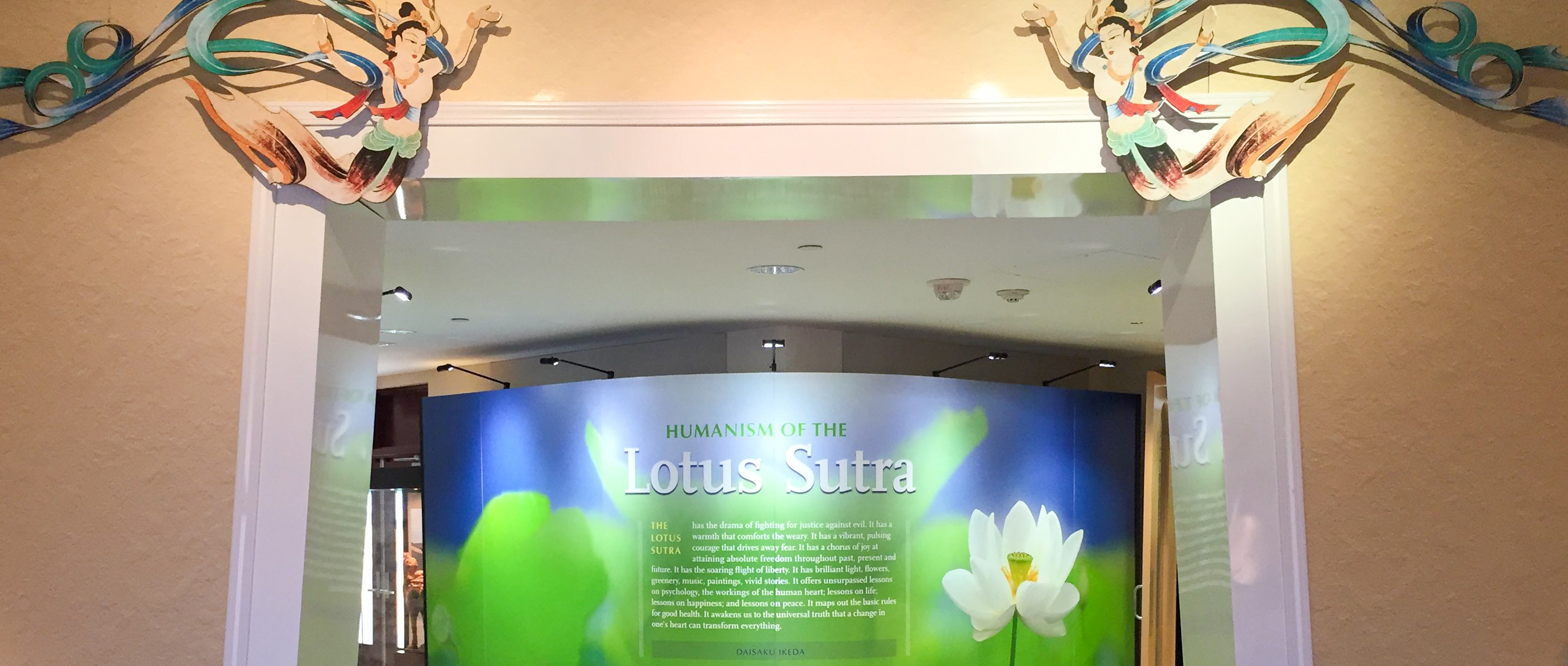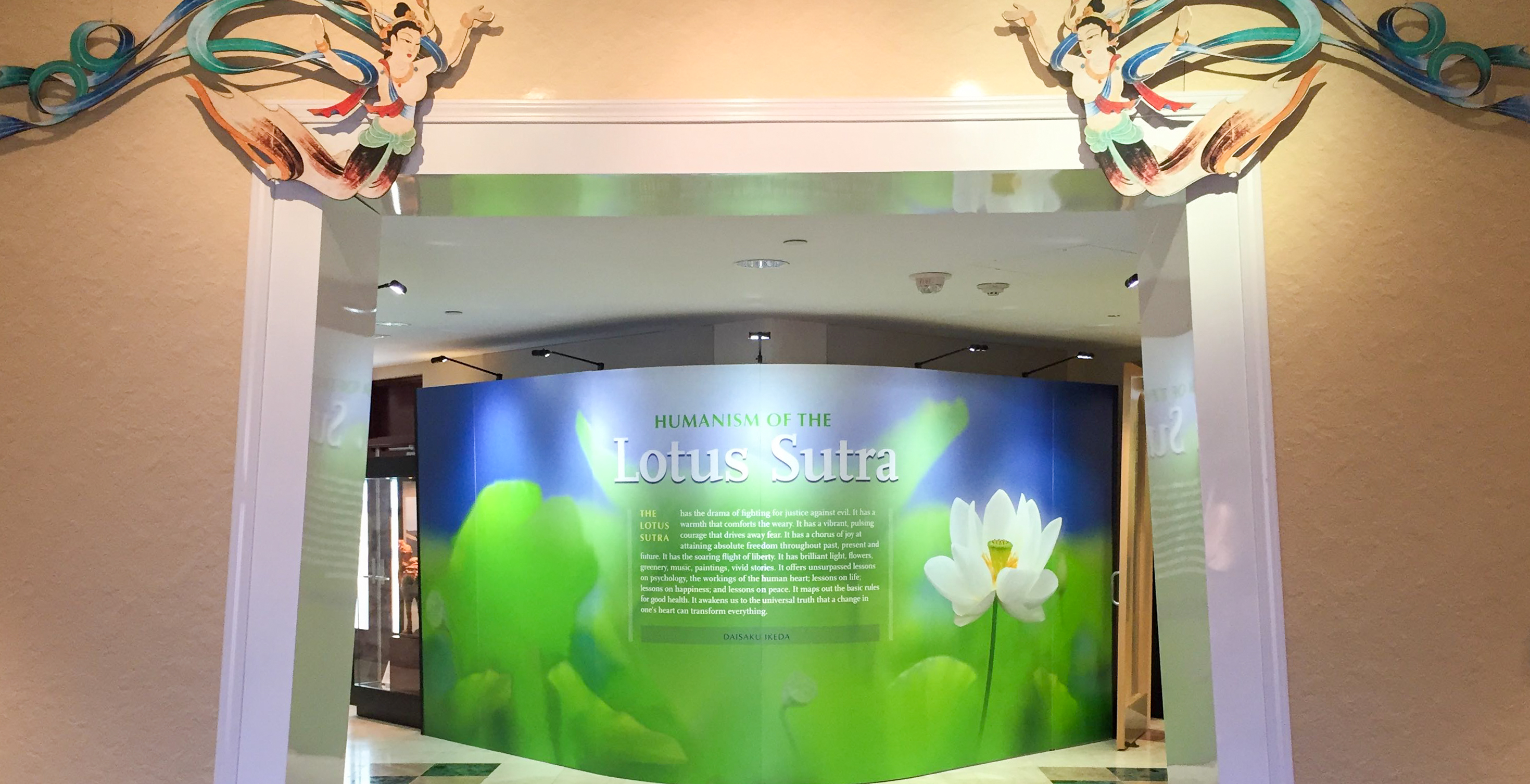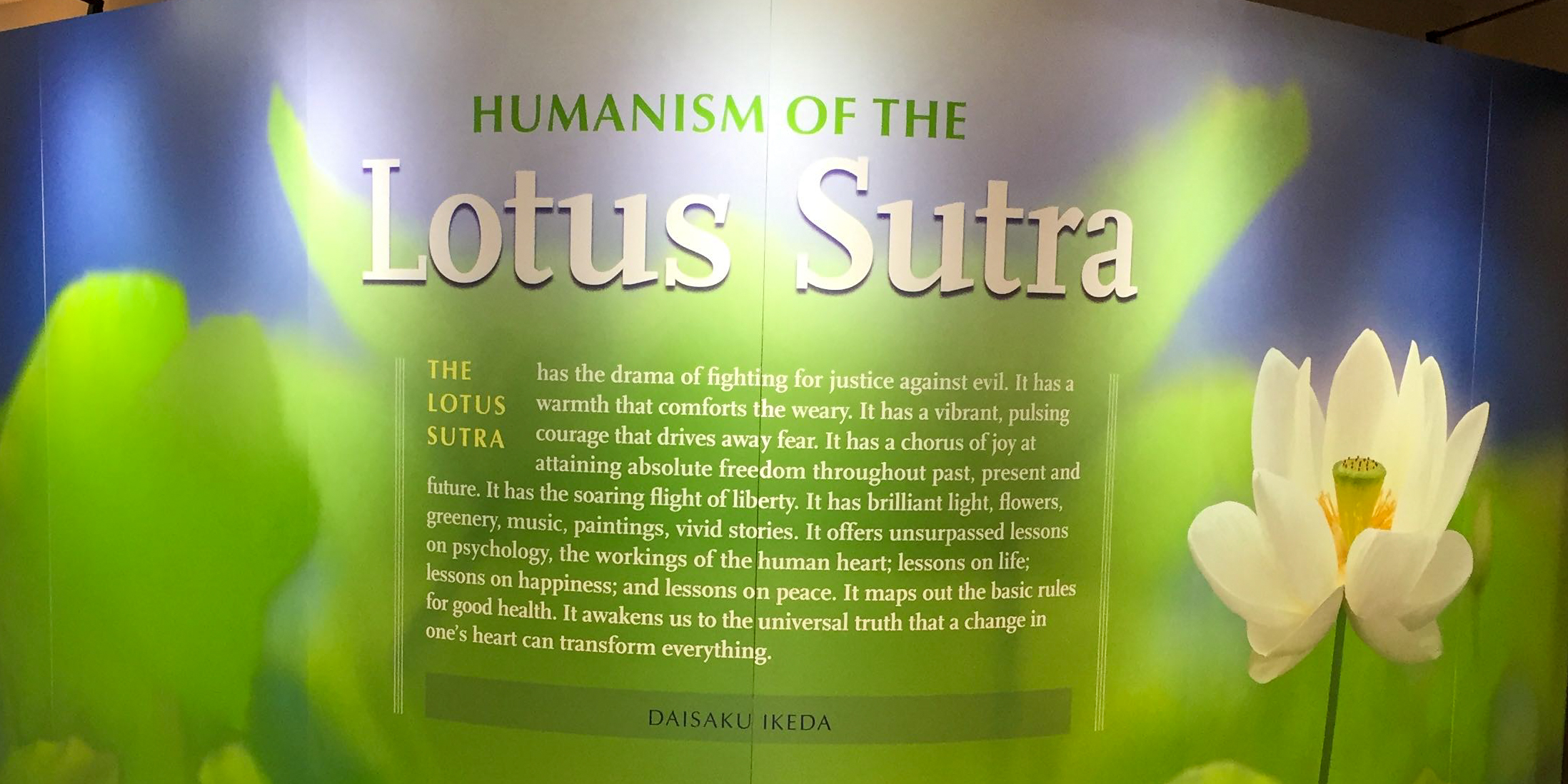
Humanism of the Lotus Sutra
The Buddha perceives that each person, each living entity, is equally precious. I am confident that this humanism of the Lotus Sutra is the universal humanism that will hold the key for the next millennium.
Daisaku Ikeda, The Wisdom of the Lotus Sutra, vol. 2, p. 87
From early times, the Lotus Sutra has been known as “the king of the sutras.” This is above all because it is a scripture of great hope that brings light to the hearts of all people.
The Lotus Sutra clearly and definitively reveals the Buddha nature that is an integral part of the lives of all people. And it makes clear that the Buddha desires and acts so that all people, by opening up this Buddha nature inherent within themselves, may attain the state of Buddhahood for themselves. The sutra further stresses that the continued observance of such action is the true mission of the bodhisattva and never ceases to praise the observance of this practice.
The Buddha nature, which is inherent in all living beings, is a universal and fundamental source or fountain of hope. When it is fully brought to light, it allows all human beings to realize their highest level of personal development and to attain unparalleled happiness and good fortune. And the Lotus Sutra is the text that most forcefully asserts this truth.
Daisaku Ikeda, The Lotus Sutra and its Opening and Closing Sutras, p. vii
The Lotus Sutra has the drama of fighting for justice against evil. It has a warmth that comforts the weary. It has a vibrant, pulsing courage that drives away fear. It has a chorus of joy at attaining absolute freedom throughout past, present, and future. It has the soaring flight of liberty. It has brilliant light, flowers, greenery, music, paintings, vivid stories. It offers unsurpassed lessons on psychology, the workings of the human heart, lessons on life, lessons on happiness, and lessons on peace. It maps out the basic rules for good health. It awakens us to the universal truth that a change in one’s heart can transform everything.
Daisaku Ikeda, The Wisdom of the Lotus Sutra, vol. 1, p. 14
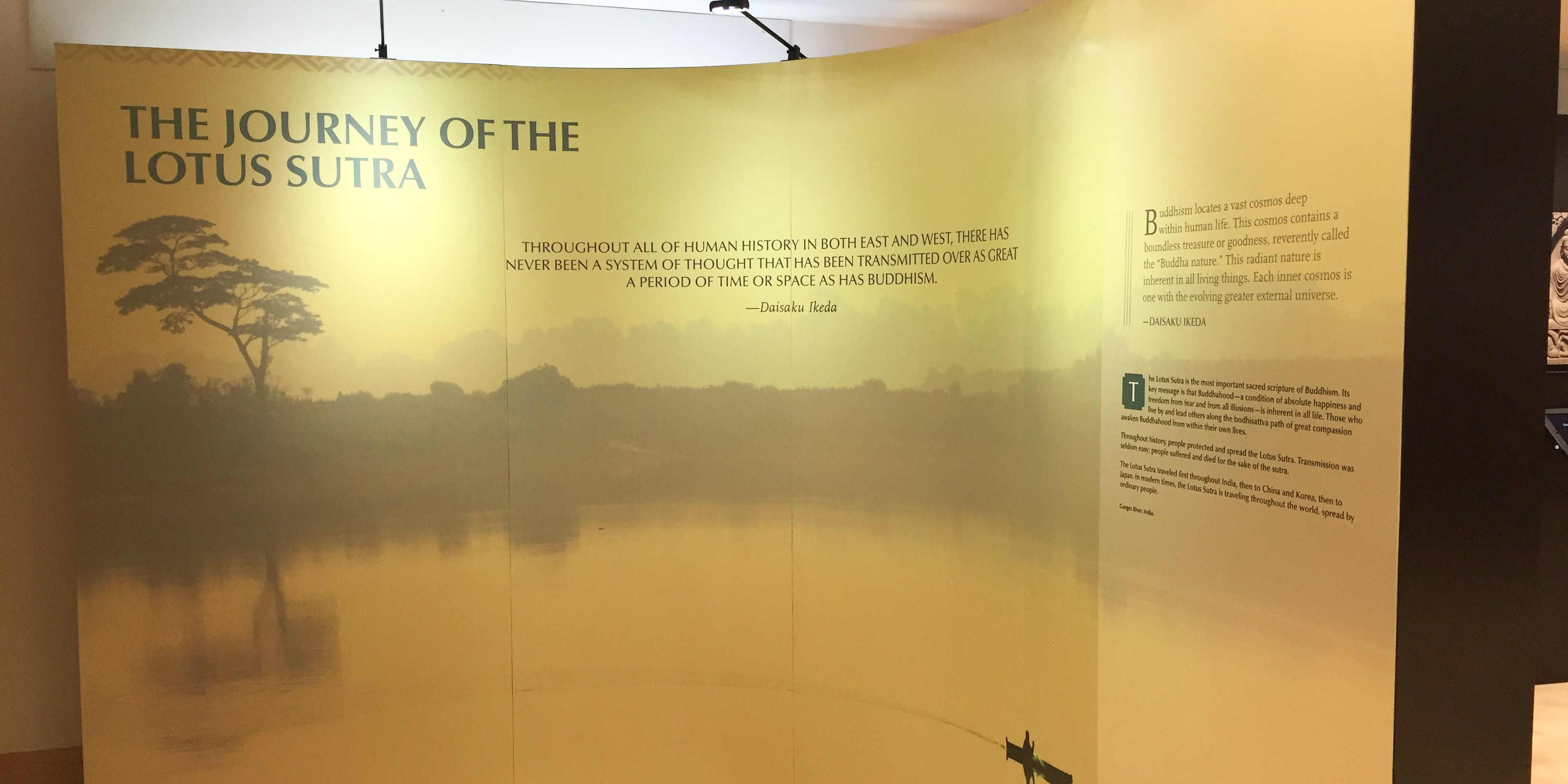
Journey of the Lotus Sutra
Throughout all of human history in both East and West, there has never been a system of thought that has been transmitted over as great a period of time or space as has Buddhism.
Daisaku Ikeda, Buddhism: The First Millennium, p. 127
Buddhism locates a vast cosmos deep within human life. This cosmos contains a boundless treasure or goodness, reverently called the “Buddha nature.” This radiant nature is inherent in all living things. Each inner cosmos is one with the evolving greater external universe.
Daisaku Ikeda, Planetary Citizenship, p. 123

Early Transmission of the Lotus Sutra
To transmit and spread the teachings of the Lotus Sutra no doubt required the efforts of bodhisattvas of truly extraordinary enlightenment and determination.
Daisaku Ikeda, Buddhism the First Millennium, p. 127
The Law does not spread by itself: because people propagate it, both the people and the Law are respectworthy.
Nichiren Daishonin, Gosho Zenshu, p. 856
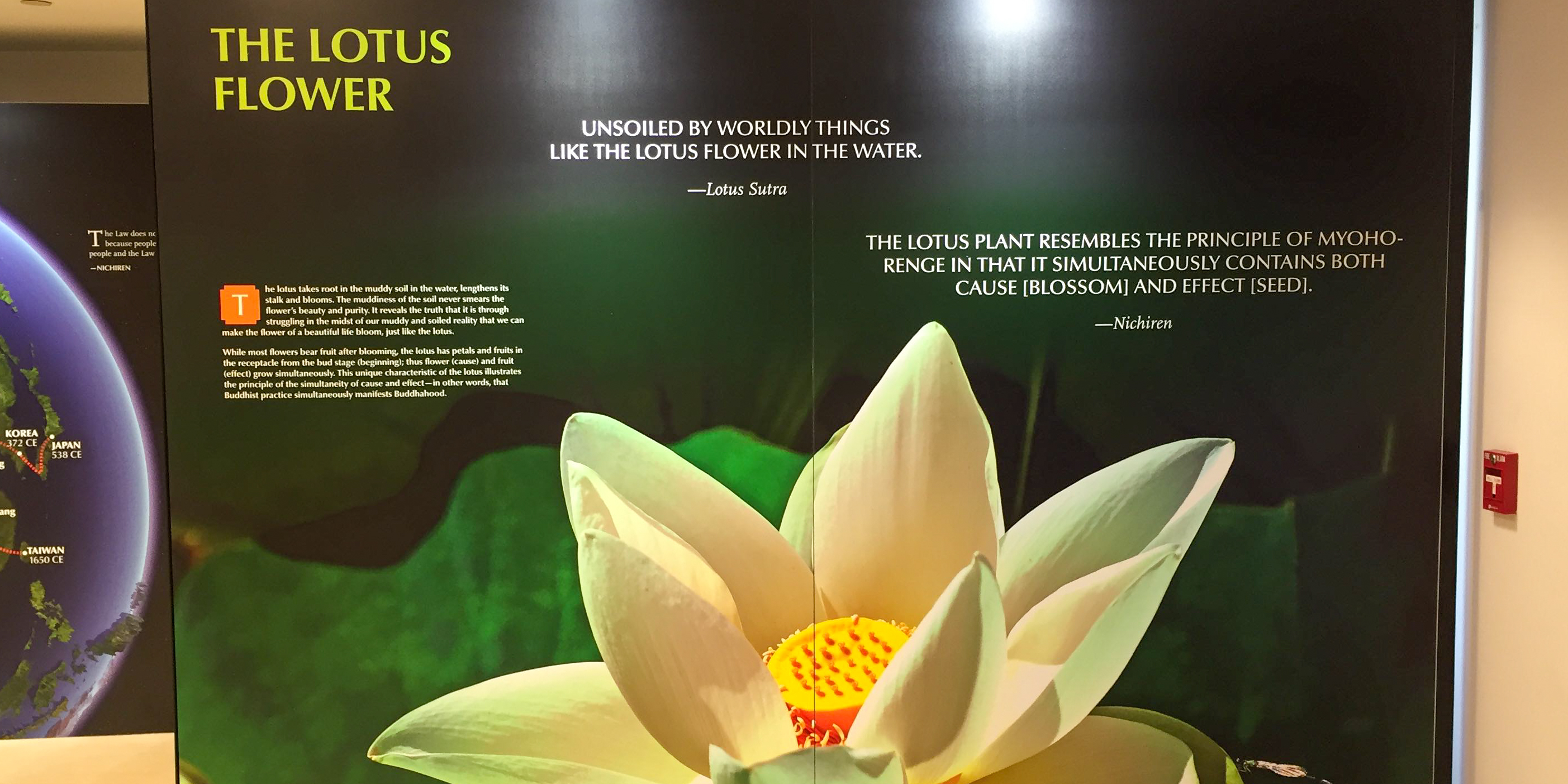
The Lotus Flower
Unsoiled by worldly things
like the lotus flower in the water.
The Lotus Sutra and its Opening and Closing Sutras, p. 263
Lotus Sutra, Chapter 15, "Emerging from the Earth"
Lotus Sutra, Chapter 15, "Emerging from the Earth"
The lotus plant resembles the principle of Myoho-renge in that it simultaneously contains both cause [blossom] and effect [seed].
Nichiren Daishonin, The Writings of Nichiren Daishonin, vol. 1, p. 856
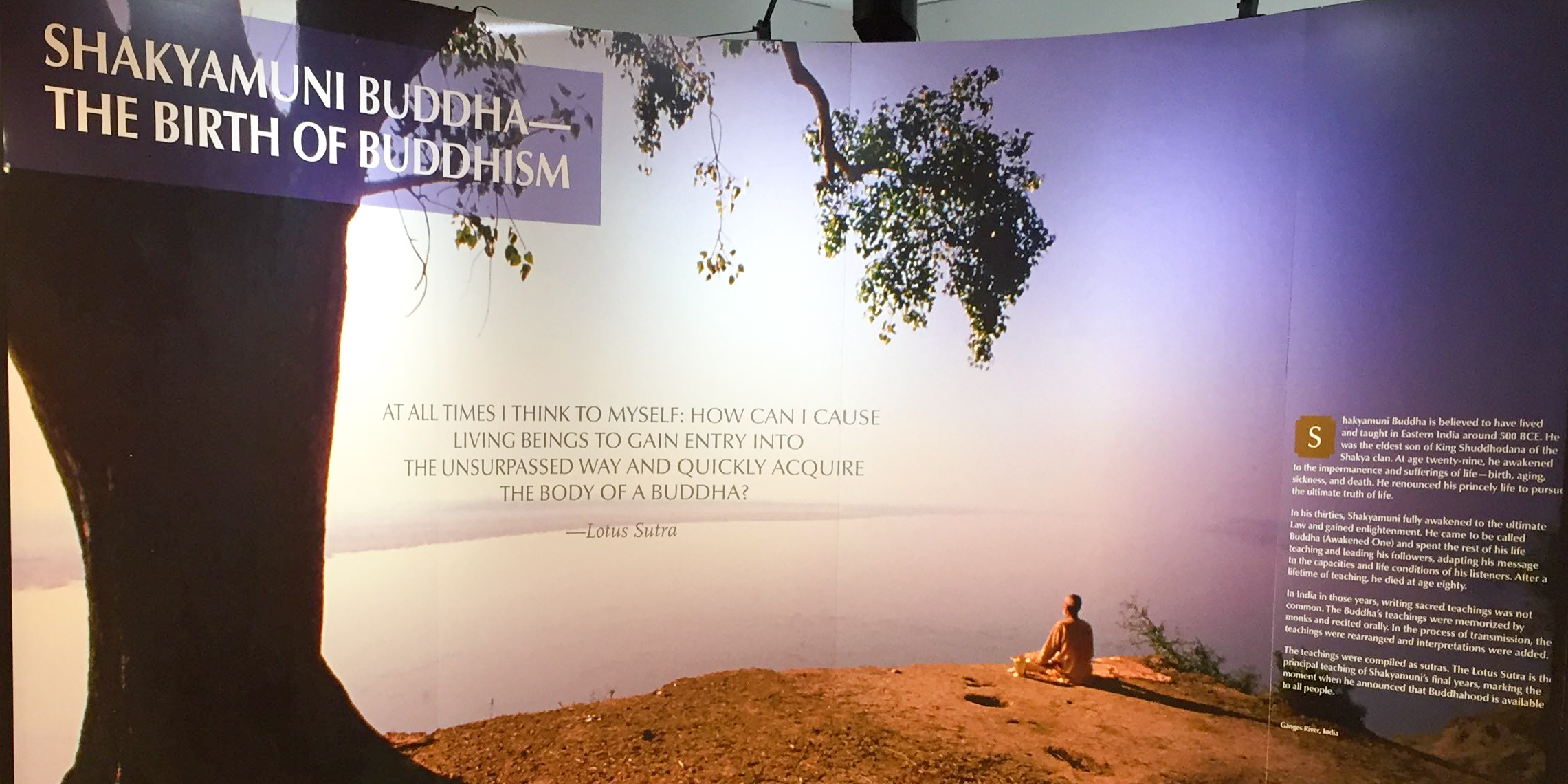
Shakyamuni Buddha - The Birth of Buddhism
At all times I think to myself: How can I cause living beings to gain entry into the unsurpassed way and quickly acquire the body of a buddha?
The Lotus Sutra and its Opening and Closing Sutras, p. 273
Lotus Sutra, Chapter 16, "The Life Span of the Thus Come One"
Lotus Sutra, Chapter 16, "The Life Span of the Thus Come One"

A Religion For All Humankind
The Buddhism of Shakyamuni was destined not simply to remain a religion of the Indian people alone. Rather, it possessed characteristics of universal appeal that permitted it to transcend national and racial boundaries and present itself as a religion for all humankind.
Daisaku Ikeda, The Flower of Chinese Buddhism, p. 1
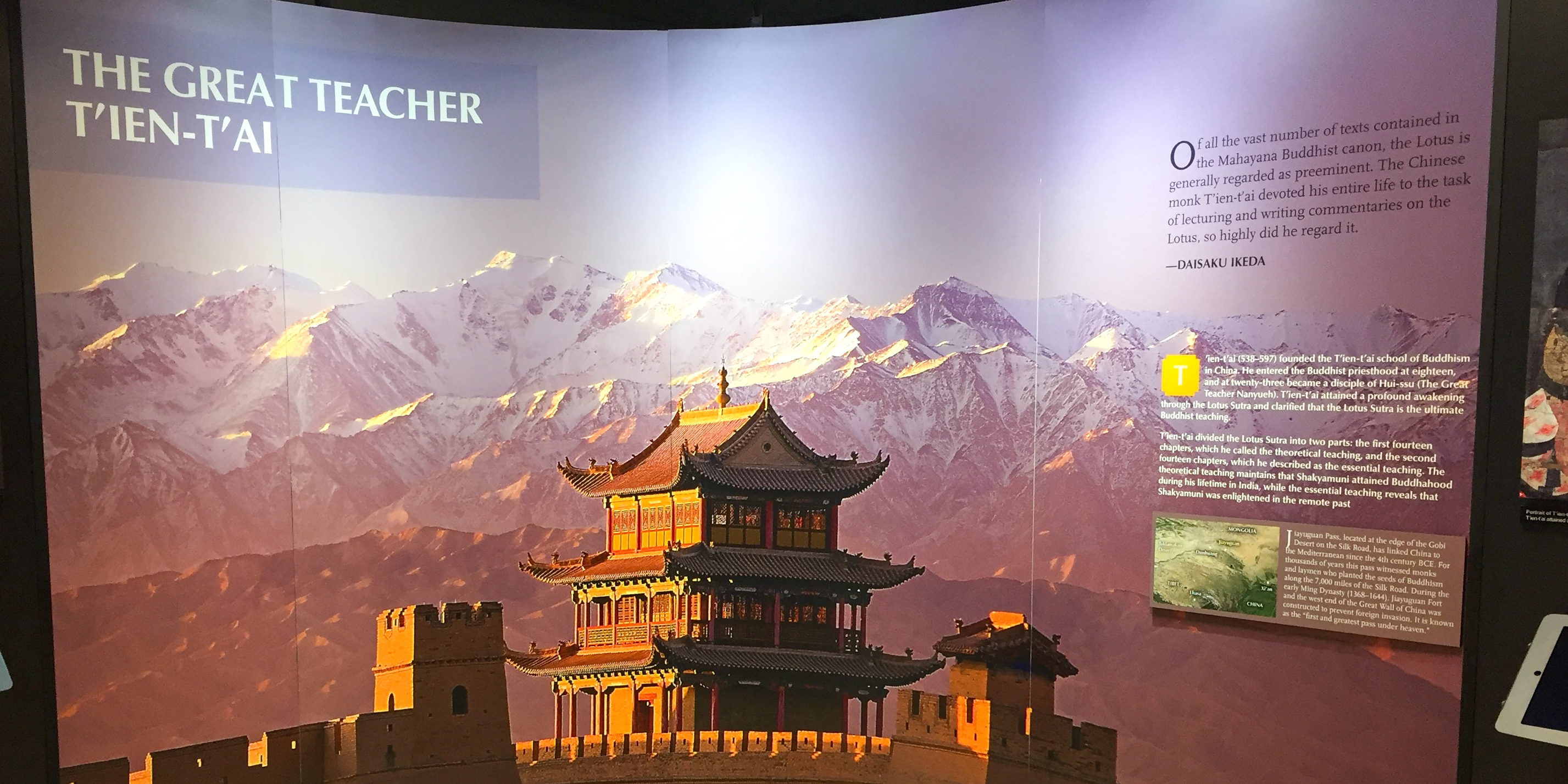
The Great Teacher T'ien-T'ai
Of all the vast number of texts contained in the Mahayana Buddhist canon, the Lotus is generally regarded as preeminent. The Chinese monk T'ien-t'ai devoted his entire life to the task of lecturing and writing commentaries on the Lotus, so highly did he regard it.
Daisaku Ikeda, Buddhism: The First Millennium, p. 113

Nichiren's Hut
The Lotus Sutra is the teaching that enables all living beings to attain the Buddha way.
Nichiren Daishonin, The Writings of Nichiren Daishonin, vol. 1, p. 60
I am convinced that the Gosho [the collected writings of Nichiren Daishonin] is the one book that can dispel the darkness of this period and illuminate the third millennium. I believe it is the Gosho of Nichiren Daishonin that is indeed the scripture for the Latter Day of the Law, the scripture for all eternity.
Daisaku Ikeda, The Writings of Nichiren Daishonin, vol. 1, p. xii
I lived in a small hut built with four posts. The roof boards did not shut out the sky, and the walls were crumbling. Rain came in as though there were no roof at all, and the snow piled up inside.
Nichiren Daishonin, The Writings of Nichiren Daishonin, vol. 2, pp. 773-74
We cut down trees and built a temporary hermitage here in the mountains. But now nearly four years have passed, and the pillars have rotted and the fence and walls fallen in.
Nichiren Daishonin, The Writings of Nichiren Daishonin, vol. 2, p. 725
I have used your offering money for the repair and reconstruction of our shabby temple building... a small lodging hall for the priests was built and also a shelter for the horses. On the eighth day, the pillars for the main priests’ quarters were set up, and on the ninth and tenth the thatching of the roof was finished.
Nichiren Daishonin, The Writings of Nichiren Daishonin, vol. 2, p. 971
In later years, after Nichiren retired to Mount Minobu, he delivered a series of lectures on the Lotus Sutra. He revealed the hidden meanings of the sutra passages that were so familiar to him, the meanings that earlier authorities on the sutra such as the Great Teacher Miao-lo had not fully brought to light. Nichiren, utilizing the work of these earlier commentators, proceeded to make clear these hidden meanings in his own lectures on the sutra.
His lectures were recorded and compiled by Nikko, one of his closest disciples. Nichiren gave his approval to the work, the completion of which is recorded as the first day of the first month of the first year of the Koan era, which corresponds to the year 1278. It later came to be known as the Ongi kuden, or The Record of the Orally Transmitted Teachings.
Daisaku Ikeda, The Record of Orally Transmitted Teachings, p. xi
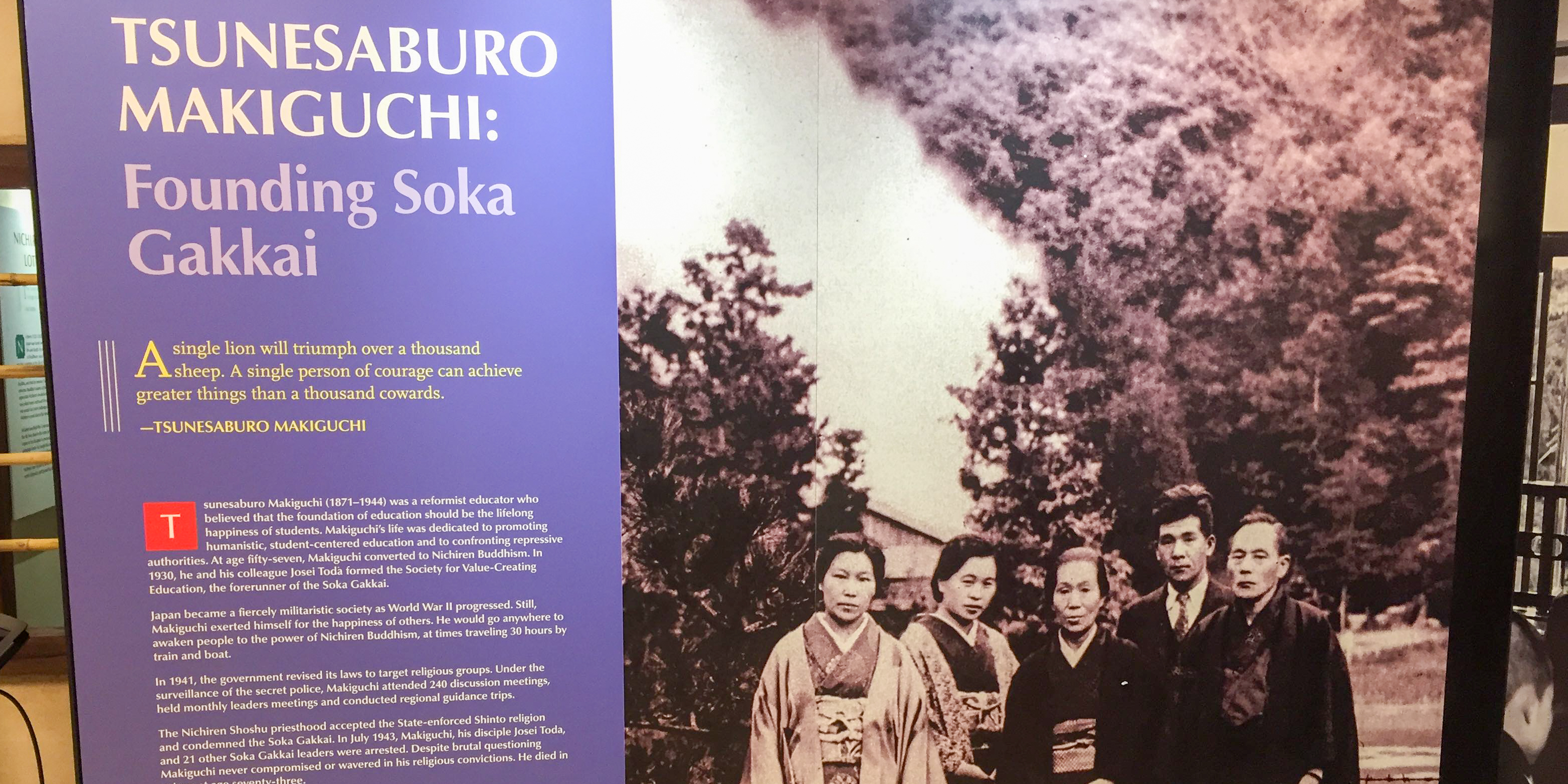
Tsunesaburo Makiguchi: Founding Soka Gakkai
A single lion will triumph over a thousand sheep. A single person of courage can achieve greater things than a thousand cowards.
Tsunesaburo Makiguchi, My Dear Friends in America, p. 413
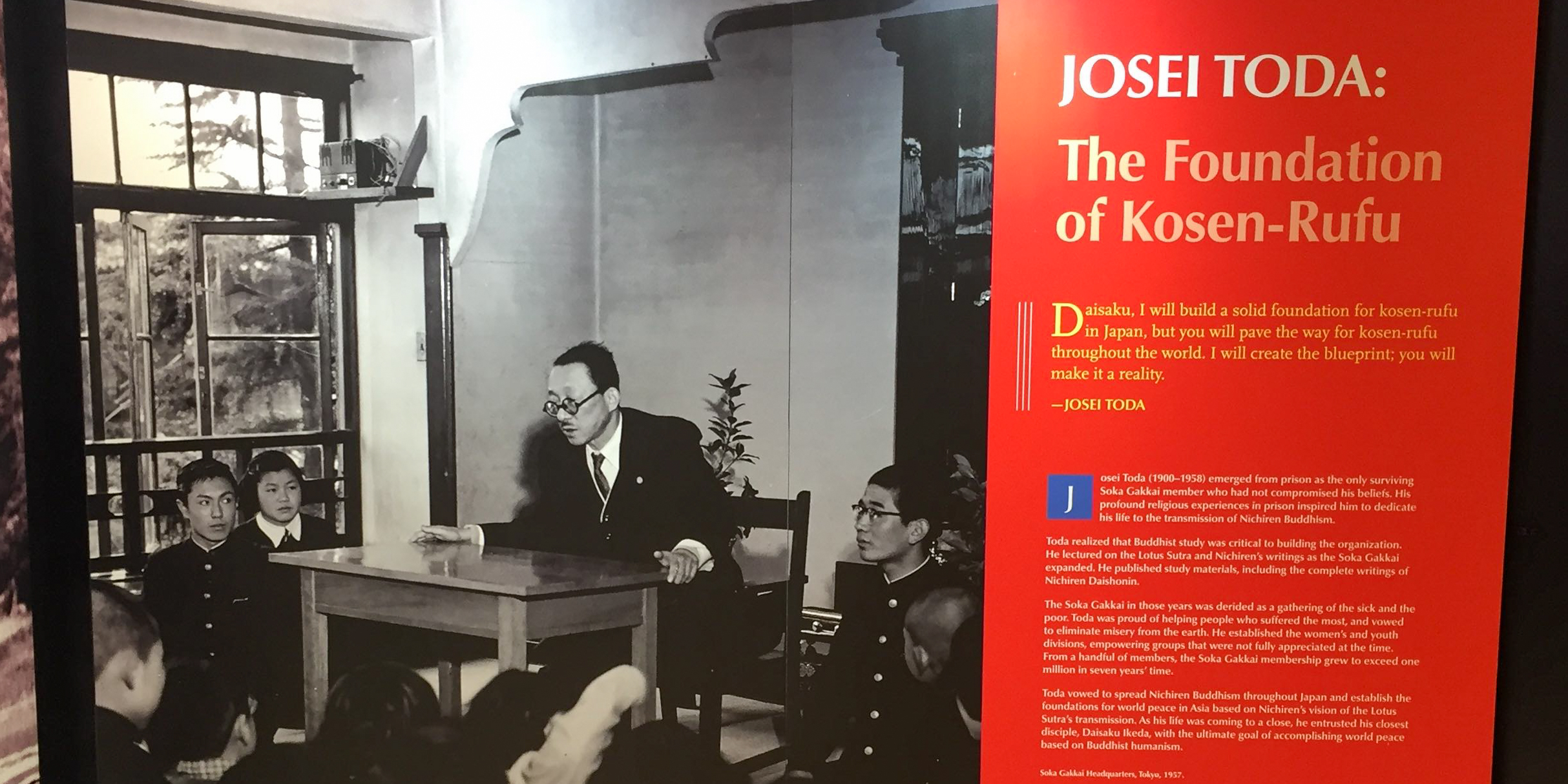
Josei Toda: The Foundation of Kosen-Rufu
Daisaku, I will build a solid foundation for kosen-rufu in Japan, but you will pave the way for kosen-rufu throughout the world. I will create the blueprint; you will make it a reality.
Josei Toda, The Human Revolution, p. 1729
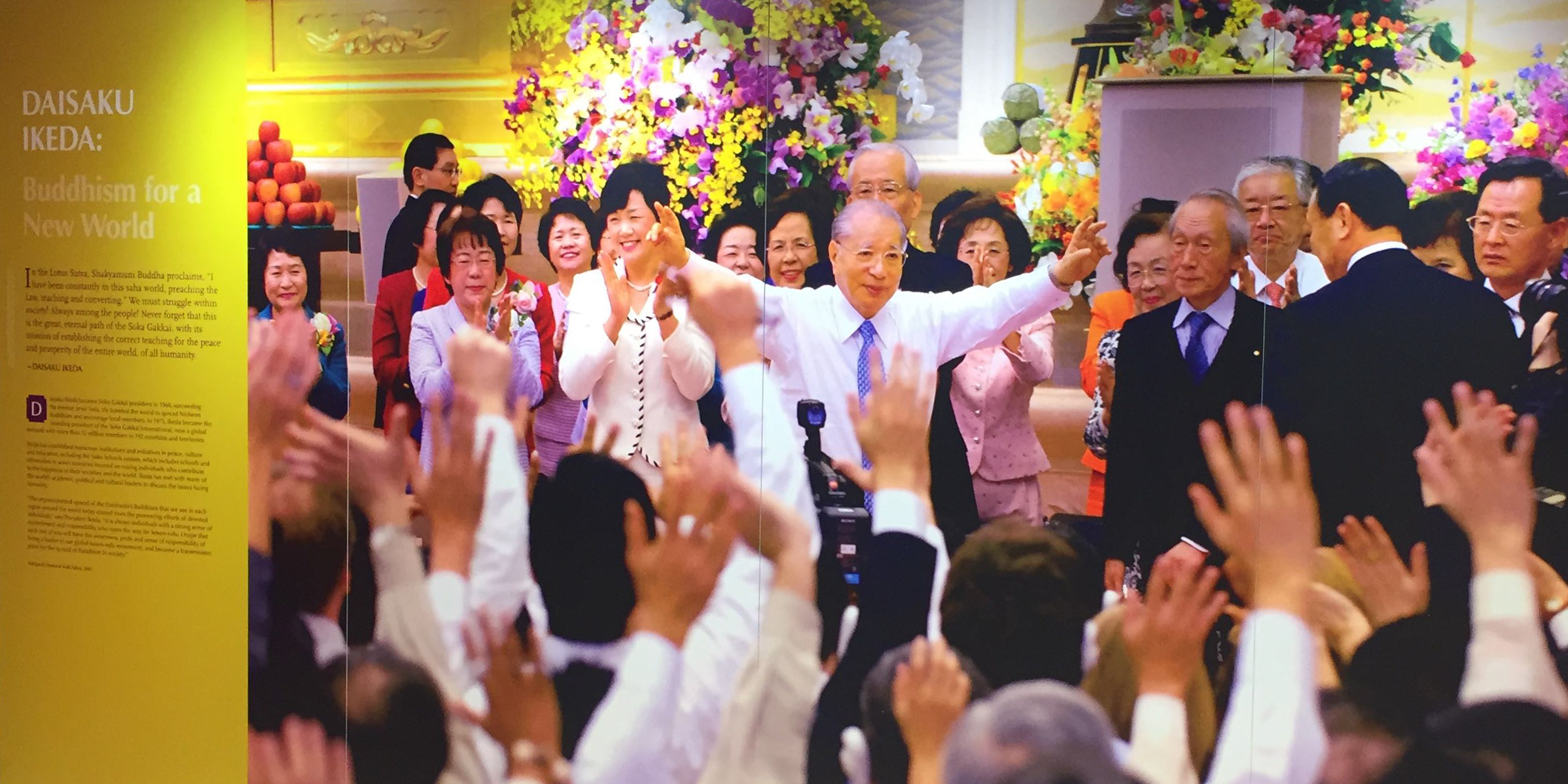
Daisaku Ikeda: Buddhism for a New World
In the Lotus Sutra, Shakyamuni Buddha proclaims, “I have been constantly in this saha world, preaching the Law, teaching and converting.” We must struggle within society! Always among the people! Never forget that this is the great, eternal path of the Soka Gakkai, with its mission of establishing the correct teaching for the peace and prosperity of the entire world, of all humanity.
Daisaku Ikeda, Seikyo Shimbun, March 29, 2003, p. 3
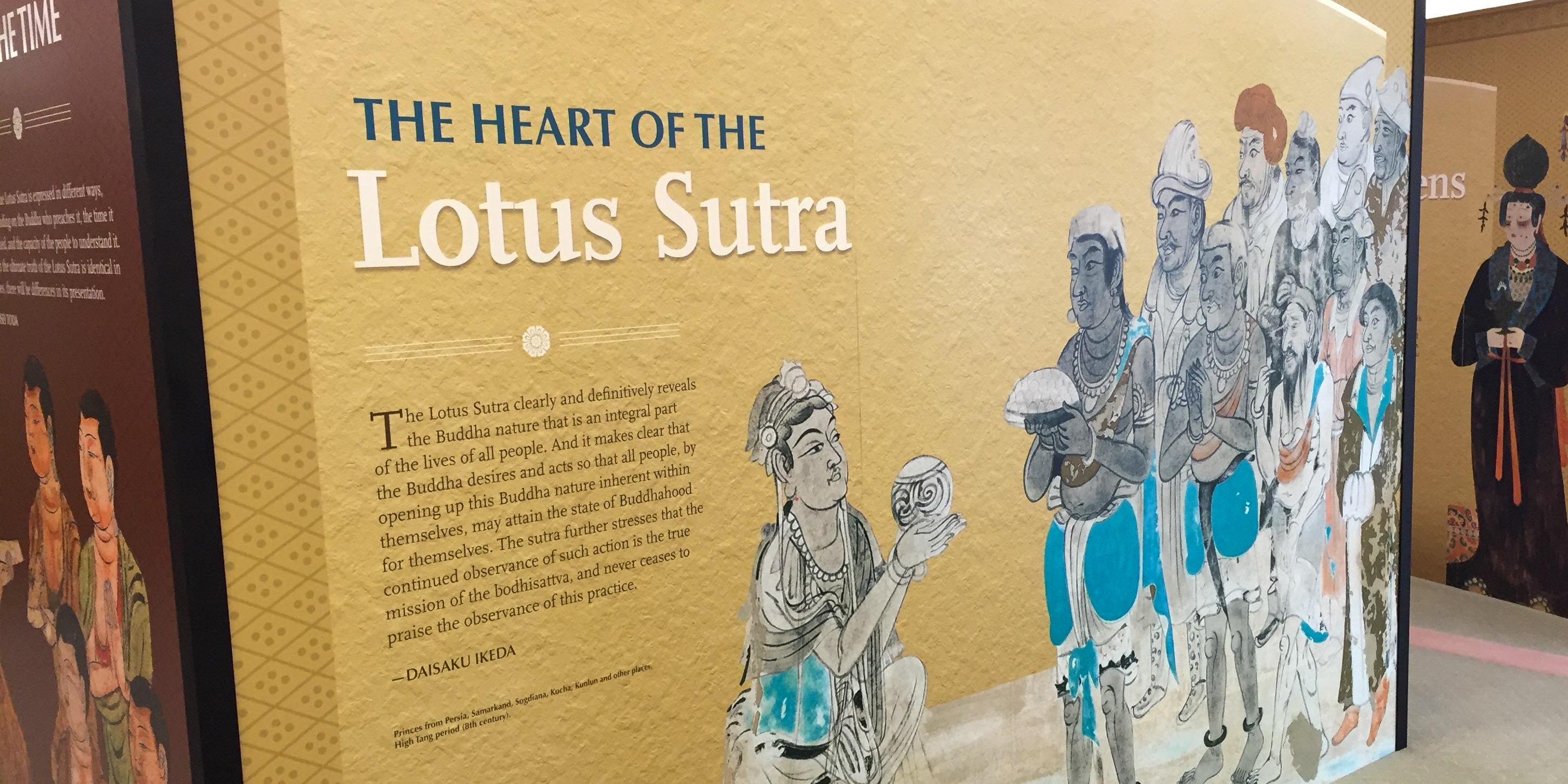
The Heart of the Lotus Sutra
The Lotus Sutra clearly and definitively reveals the Buddha nature that is an integral part of the lives of all people. And it makes clear that the Buddha desires and acts so that all people, by opening up this Buddha nature inherent within themselves, may attain the state of Buddhahood for themselves. The sutra further stresses that the continued observance of such action is the true mission of the bodhisattva, and never ceases to praise the observance of this practice.
Daisaku Ikeda, The Lotus Sutra and its Opening and Closing Sutras, p. vii
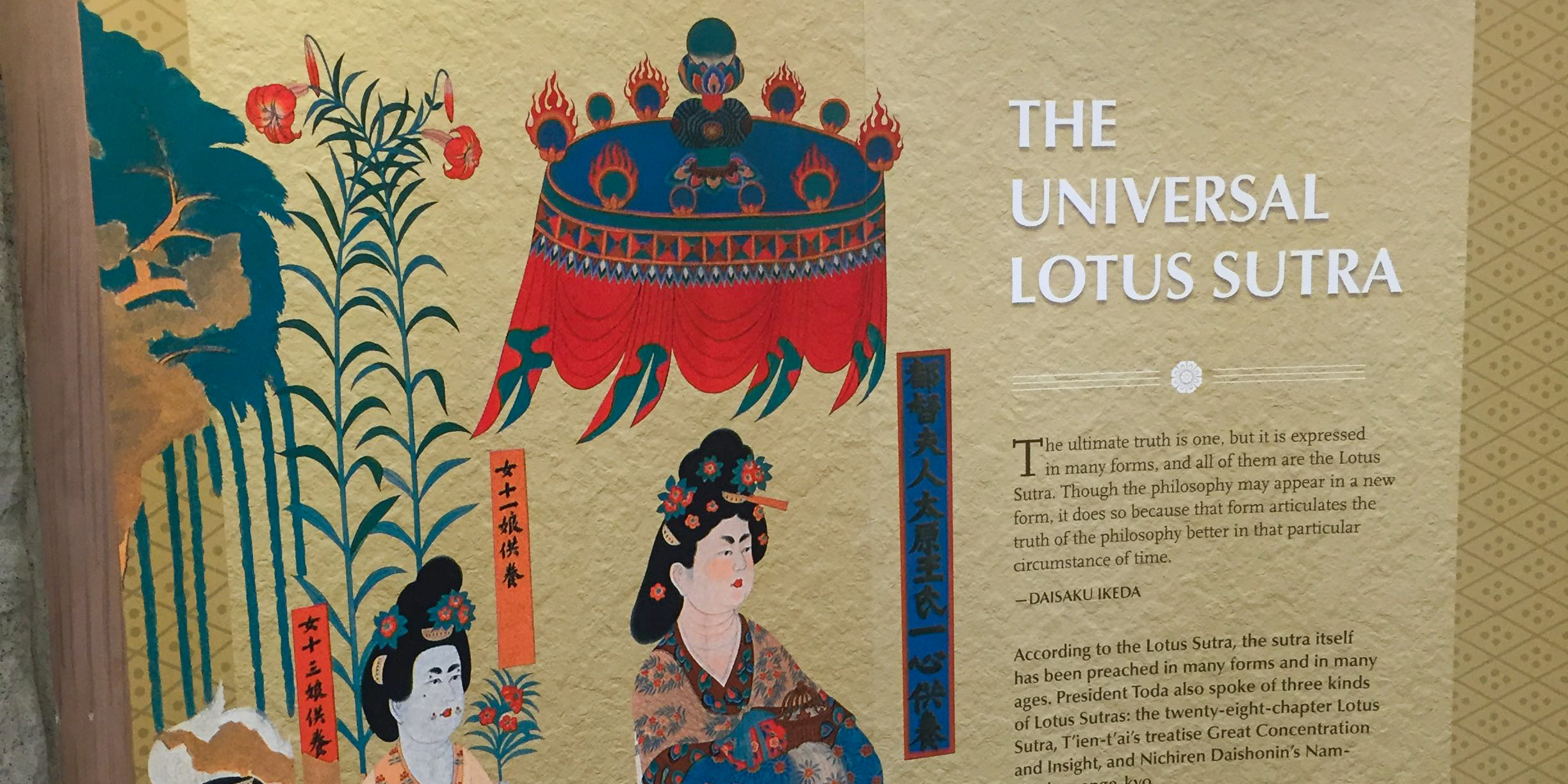
The Universal Lotus Sutra
The ultimate truth is one, but it is expressed in many forms, and all of them are the Lotus Sutra... Though the philosophy may appear in a new form, it does so because that form articulates the truth of the philosophy better in that particular circumstance of time.
Daisaku Ikeda, The Wisdom of the Lotus Sutra, vol. 1, pp. 68-69
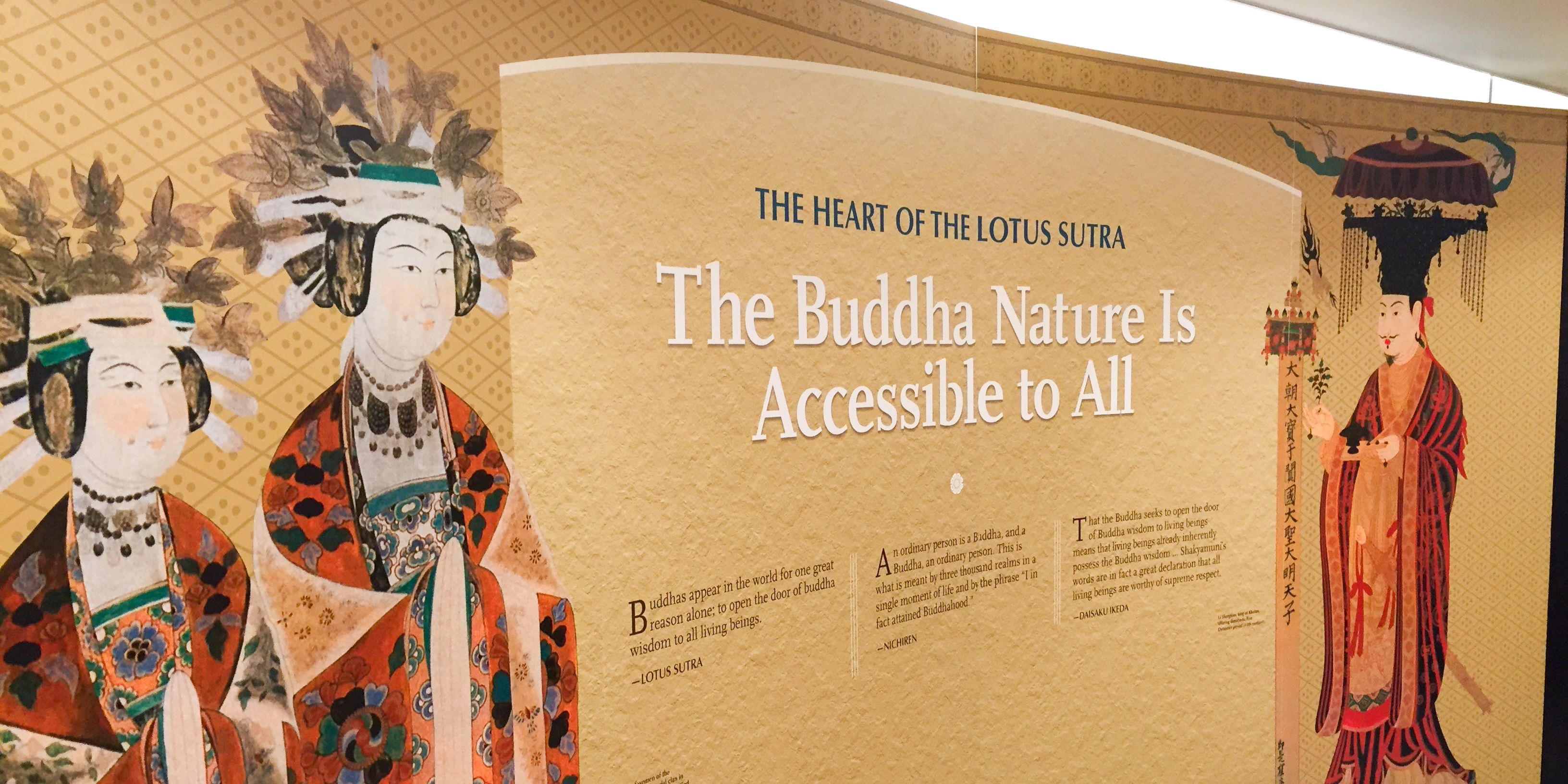
The Buddha Nature is Accessible to All
Buddhas … appear in the world for one great reason alone … to open the door of Buddha wisdom to all living beings.
Lotus Sutra, Chapter 2, "Expedient Means"
An ordinary person is a Buddha, and a Buddha, an ordinary person. This is what is meant by three thousand realms in a single moment of life and by the phrase “I in fact attained Buddhahood.”
Nichiren Daishonin, The Writings of Nichiren Daishonin, vol. 1, p. 36
That the Buddha seeks to open the door of Buddha wisdom to living beings means that living beings already inherently possess the Buddha wisdom … Shakyamuni’s words are in fact a great declaration that all living beings are worthy of supreme respect.
Daisaku Ikeda, The Wisdom of the Lotus Sutra, vol. 1, p. 115

The Bodhisattva Path Awakens Our Buddha Nature
You will all practice the bodhisattva way and will then be able to attain Buddhahood!
Lotus Sutra, Chapter 20, "The Bodhisattva Never Disparaging"
If you are of the same mind as Nichiren, you must be a Bodhisattva of the Earth.
Nichiren Daishonin, The Writings of Nichiren Daishonin, vol. 1, p. 385
When we look after and care for others—that is, help others draw forth the strength to live—our own strength to live increases. When we help people expand their state of life, our lives also expand. This is the marvel of the bodhisattva path; actions to benefit others cannot be separated from actions to benefit oneself.
Daisaku Ikeda, The Wisdom of the Lotus Sutra, vol. 4, p. 181
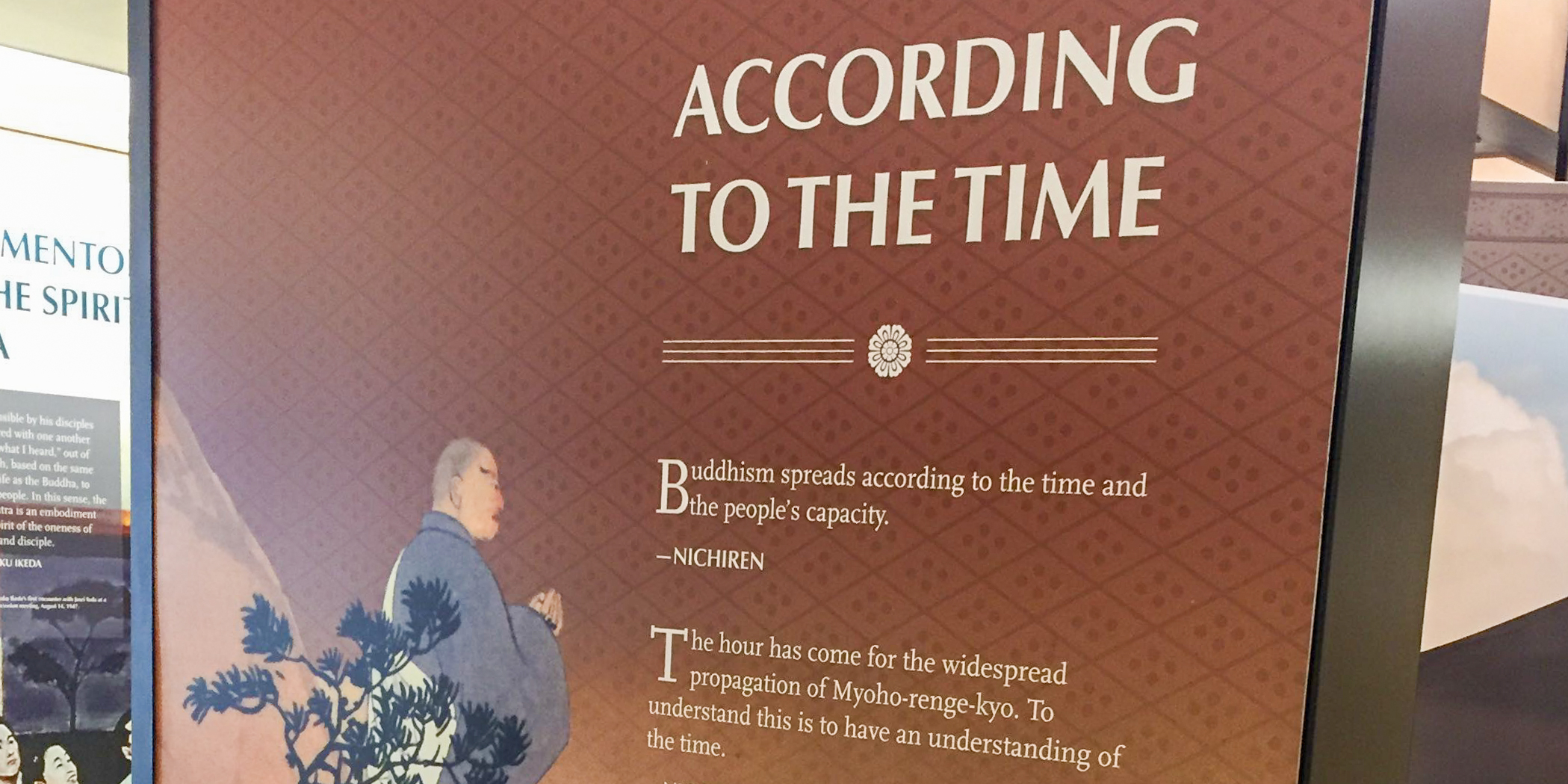
According to the Time
Buddhism spreads according to the time and the people’s capacity.
Nichiren Daishonin, The Writings of Nichiren Daishonin, vol. 1, p. 861
The hour has come for the widespread propagation of Myoho-renge-kyo. To understand this is to have an understanding of the time.
Nichiren Daishonin, The Writings of Nichiren Daishonin, vol. 1, p. 51
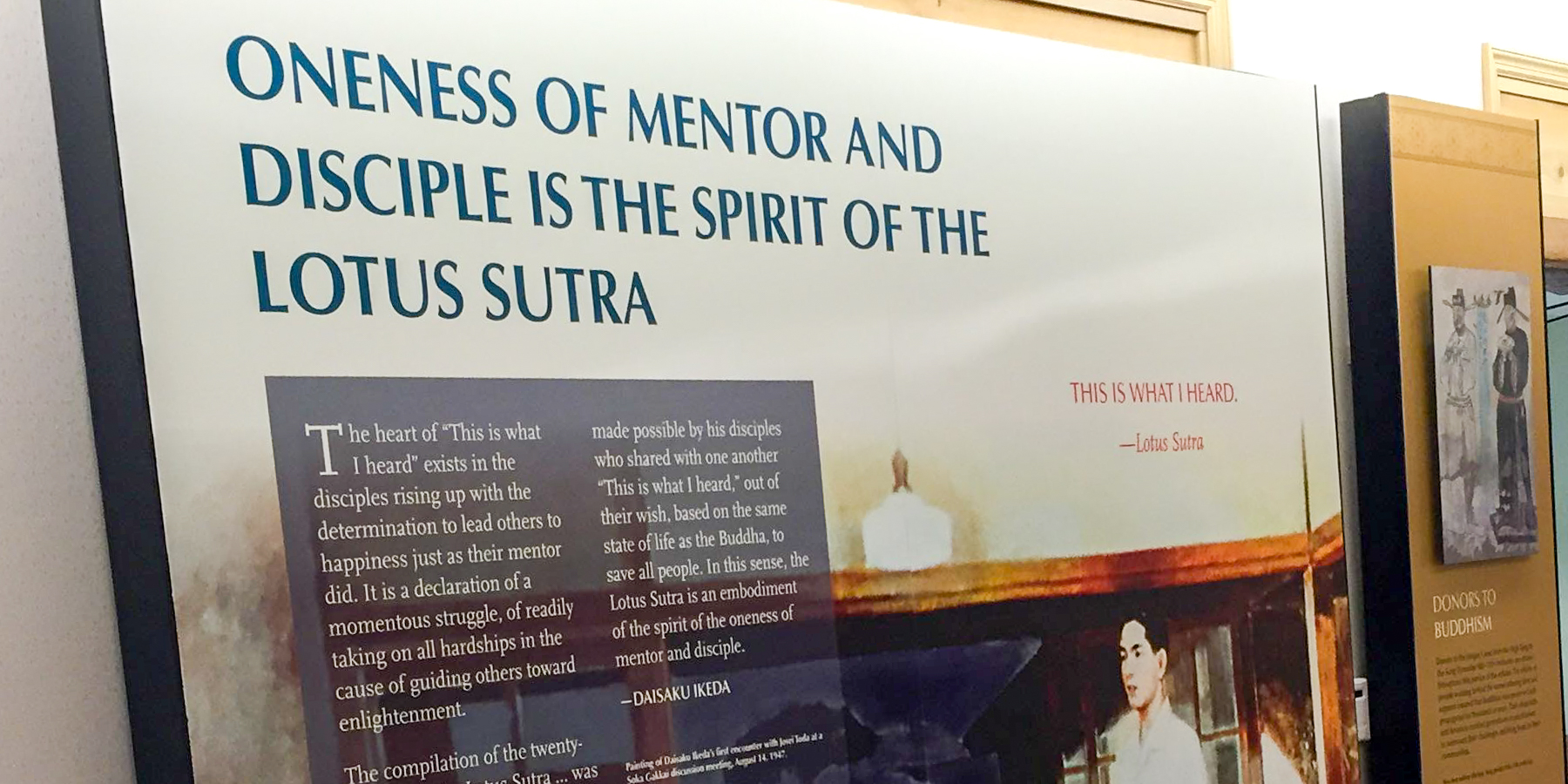
The Oneness of Mentor and Disciple is the Spirit of the Lotus Sutra
This is what I heard.
The Lotus Sutra and its Opening and Closing Sutras, p. 35
Lotus Sutra, Chapter 1, "Introduction"
Lotus Sutra, Chapter 1, "Introduction"
The heart of “This is what I heard” exists in the disciples rising up with the determination to lead others to happiness just as their mentor did. It is a declaration of a momentous struggle, of readily taking on all hardships in the cause of guiding others toward enlightenment.The compilation of the twenty-eight–chapter Lotus Sutra… was made possible by his disciples who shared with one another “This is what I heard,” out of their wish, based on the same state of life as the Buddha, to save all people. In this sense, the Lotus Sutra is an embodiment of the spirit of the oneness of mentor and disciple.
Daisaku Ikeda, The Wisdom of the Lotus Sutra, vol. 1, pp. 75-76
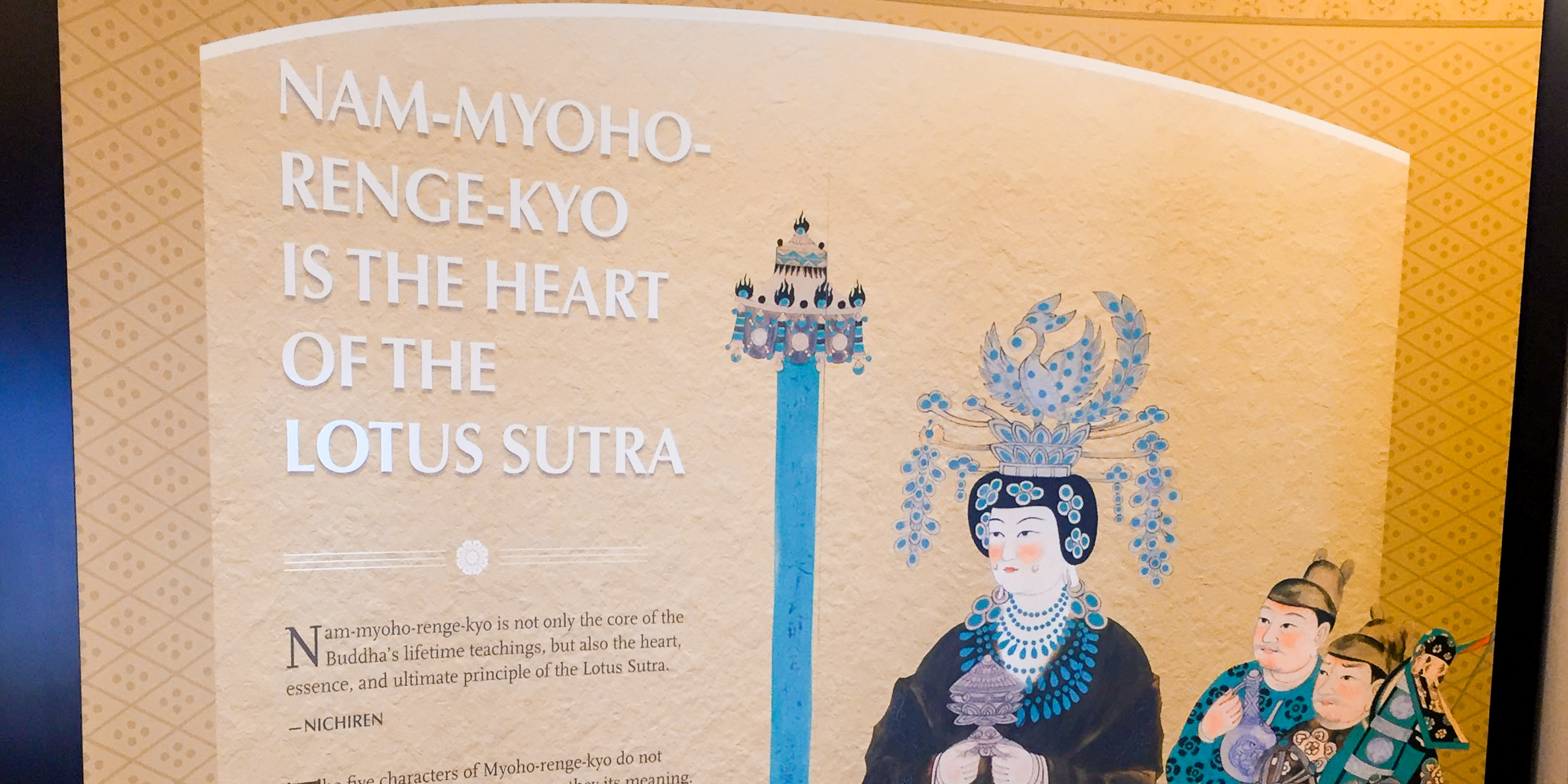
Nam-Myoho-Renge-Kyo is the Heart of the Lotus Sutra
Nam-myoho-renge-kyo is not only the core of the Buddha’s lifetime teachings, but also the heart, essence, and ultimate principle of the Lotus Sutra.
Nichiren Daishonin, The Writings of Nichiren Daishonin, vol. 1, p. 860
The five characters of Myoho-renge-kyo do not represent the sutra text, nor are they its meaning. They are nothing other than the intent of the entire sutra. So, even though the beginners in Buddhist practice may not understand their significance, by practicing these five characters, they will naturally conform to the sutra’s intent.
Nichiren Daishonin, The Writings of Nichiren Daishonin, vol. 1, p. 788
The five characters of Myoho-renge-kyo are the Lotus Sutra appropriate to this age of the Latter Day of the Law, they are the sutra’s essence.
Daisaku Ikeda, The Humanism of the Lotus Sutra, p. 5
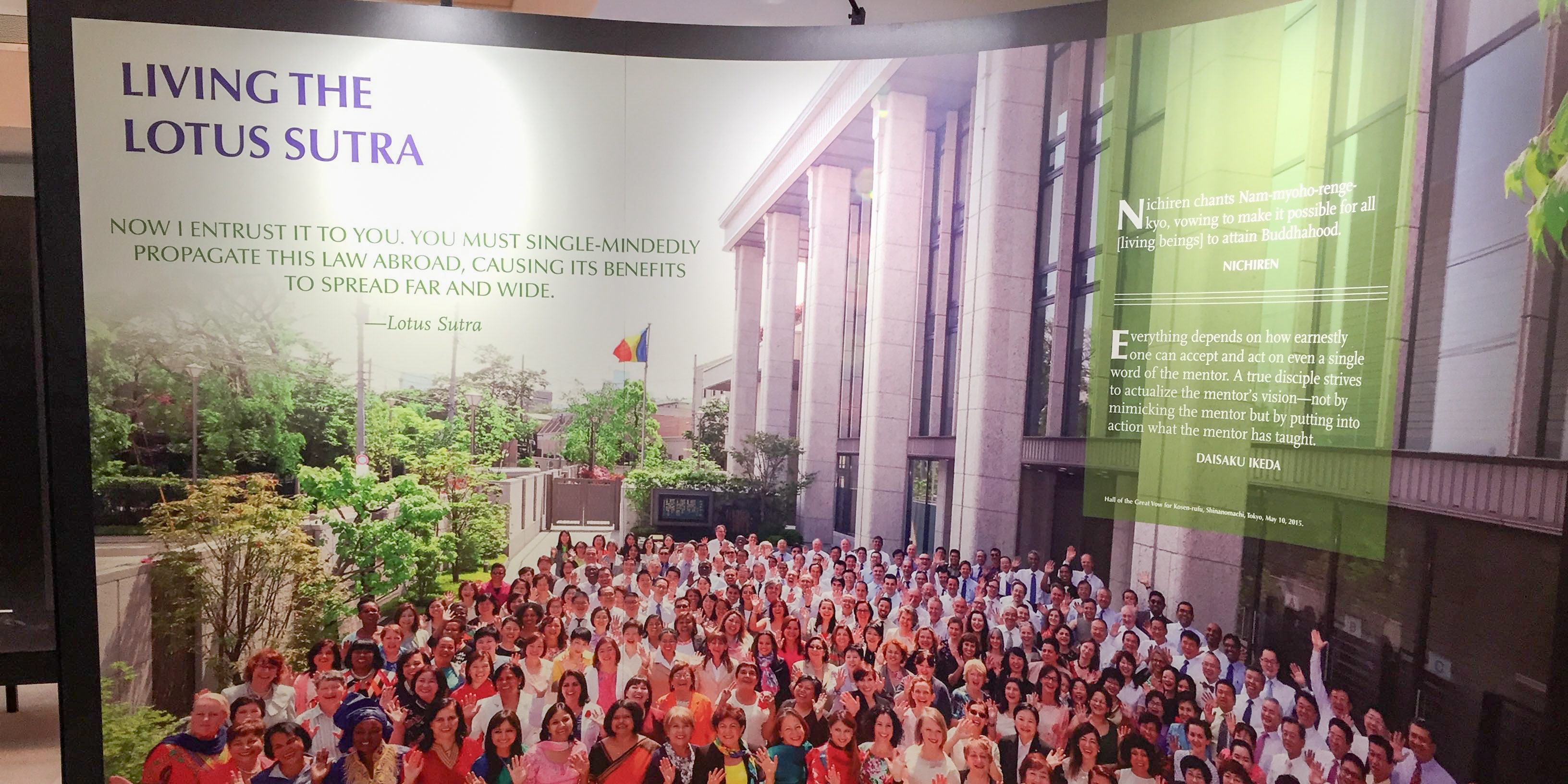
Living the Lotus Sutra
Now I entrust it to you. You must single-mindedly propagate this Law abroad, causing its benefits to spread far and wide.
The Lotus Sutra and its Opening and Closing Sutras, p. 319
Lotus Sutra, Chapter 22, "Entrustment"
Lotus Sutra, Chapter 22, "Entrustment"
Nichiren chants Nam-myoho-renge-kyo, vowing to make it possible for all [living beings] to attain Buddhahood.
Nichiren Daishonin, The Record of Orally Transmitted Teachings, p. 40
Everything depends on how earnestly one can accept and act on even a single word of the mentor. A true disciple strives to actualize the mentor’s vision—not by mimicking the mentor but by putting into action what the mentor has taught.
Daisaku Ikeda, The Wisdom of the Lotus Sutra, vol. 5, p. 238
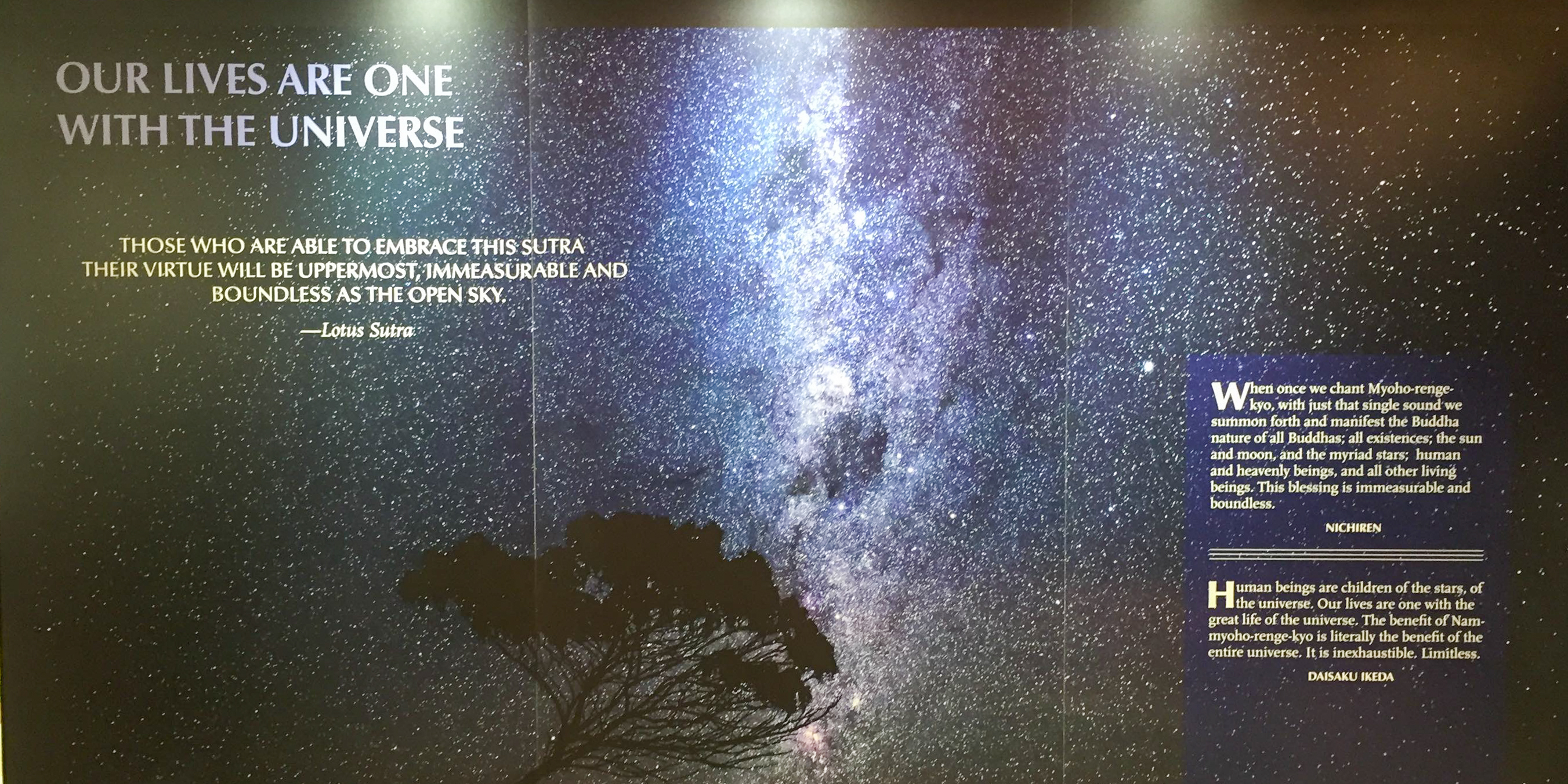
Our Lives Are One With the Universe
Those who are able to embrace this sutra... Their virtue will be uppermost, immeasurable and boundless as the open sky.
The Lotus Sutra and its Opening and Closing Sutras, p. 282
Lotus Sutra, Chapter 17, "Distinctions in Benefits"
Lotus Sutra, Chapter 17, "Distinctions in Benefits"
When once we chant Myoho-renge-kyo, with just that single sound we summon forth and manifest the Buddha nature of all Buddhas; all existences; … the sun and moon, and the myriad stars; … human and heavenly beings, and all other living beings. This blessing is immeasurable and boundless.
Nichiren Daishonin, The Writings of Nichiren Daishonin, vol. 1, p. 887
Human beings are children of the stars, of the universe. Our lives are one with the great life of the universe. The benefit of Nam-myoho-renge-kyo is literally the benefit of the entire universe. It is inexhaustible. Limitless.
Daisaku Ikeda, The Wisdom of the Lotus Sutra, vol. 5, p. 17
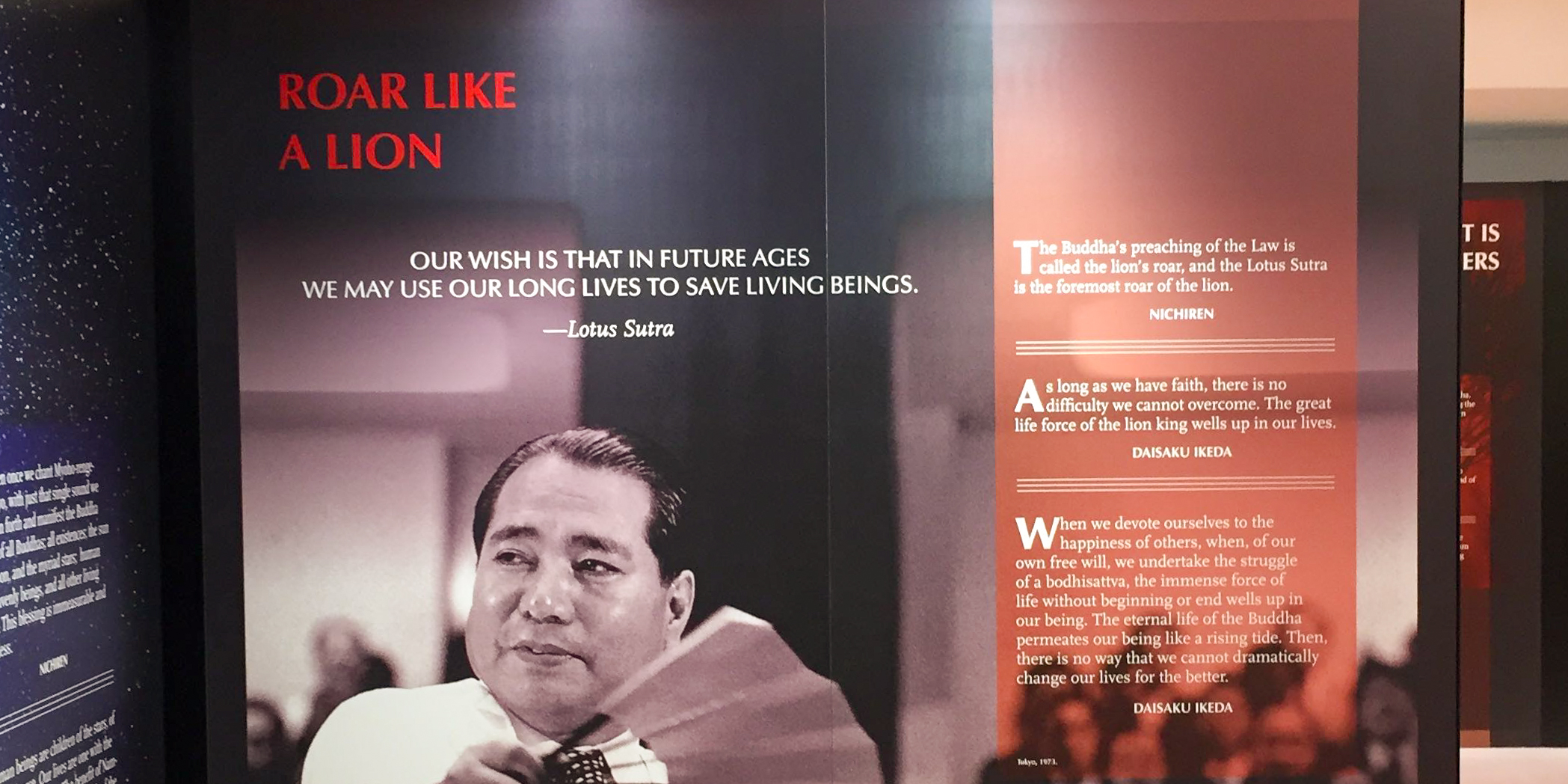
Roar Like a Lion
Our wish is that in future ages we may use our long lives to save living beings.
The Lotus Sutra and its Opening and Closing Sutras, 280
Lotus Sutra, Chapter 17, "Distinctions in Belief"
Lotus Sutra, Chapter 17, "Distinctions in Belief"
The Buddha’s preaching of the Law is called the lion’s roar, and the Lotus Sutra is the foremost roar of the lion.
Nichiren Daishonin, The Writings of Nichiren Daishonin, vol. 1, p. 332
As long as we have faith, there is no difficulty we cannot overcome. The great life force of the lion king wells up in our lives.
Daisaku Ikeda, The Wisdom of the Lotus Sutra, vol. 5, p. 18
When we devote ourselves to the happiness of others, when, of our own free will, we undertake the struggle of a bodhisattva, the immense force of life without beginning or end wells up in our being. The eternal life of the Buddha permeates our being like a rising tide. Then, there is no way that we cannot dramatically change our lives for the better.
Daisaku Ikeda, The Wisdom of the Lotus Sutra, vol. 5, p. 24
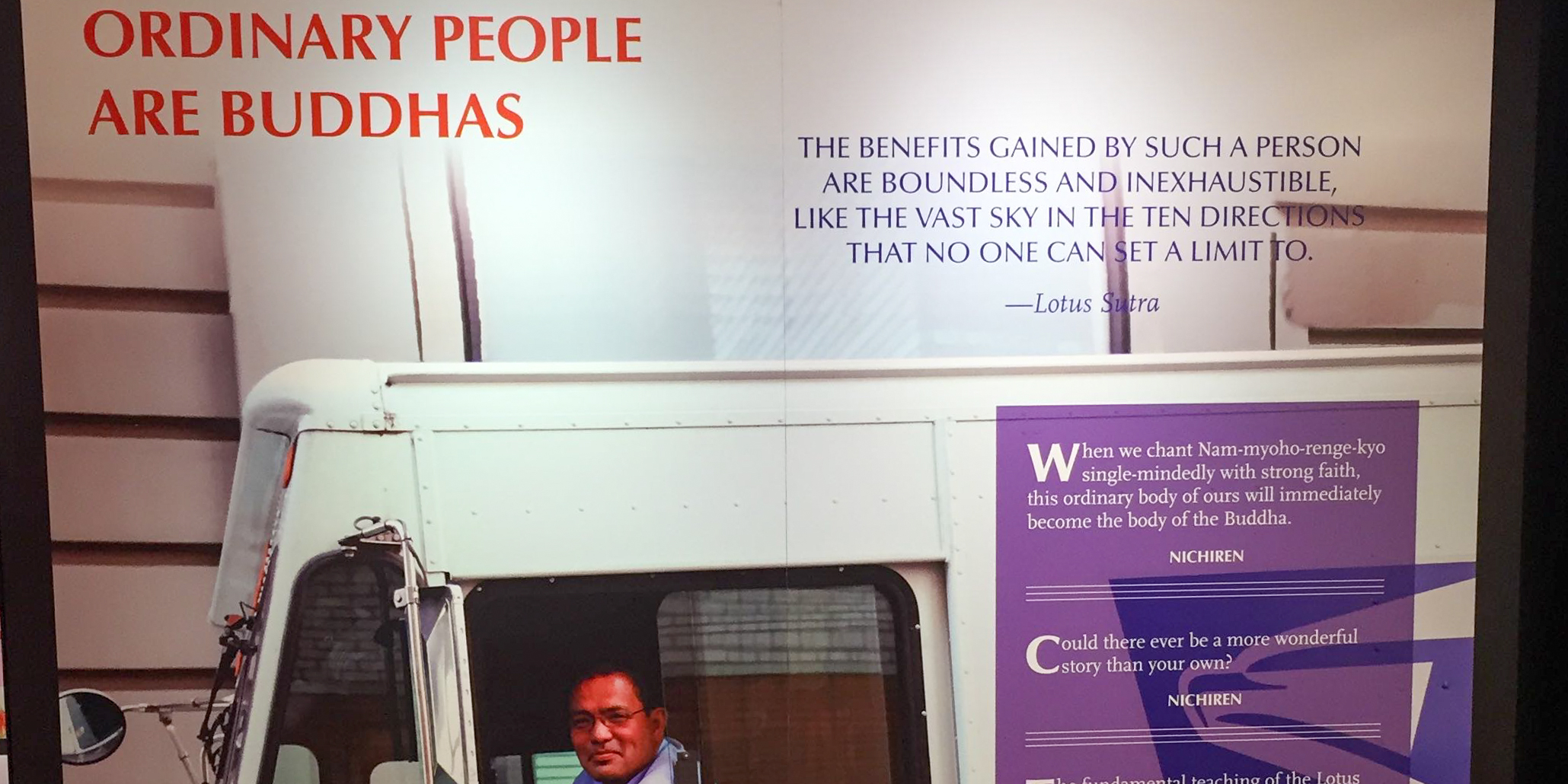
Ordinary People Are Buddhas
The benefits gained by such a person
are boundless and inexhaustible,
like the vast sky in the ten directions
that no one can set a limit to.
The Lotus Sutra and its Opening and Closing Sutras, p. 317
Lotus Sutra, Chapter 21, "Supernatural Powers of the Thus Come One"
Lotus Sutra, Chapter 21, "Supernatural Powers of the Thus Come One"
When we chant Nam-myoho-renge-kyo single-mindedly with strong faith, this ordinary body of ours will immediately become the body of the Buddha.
Nichiren Daishonin, Gosho Zenshu, p. 872
Could there ever be a more wonderful story than your own?
Nichiren Daishonin, The Writings of Nichiren Daishonin, vol. 1, p. 499
The fundamental teaching of the Lotus Sutra and of the Buddhism of Nichiren Daishonin is that ordinary people—just as they are—should live, assert themselves, and strive wholeheartedly for happiness while fully expressing their humanity. To do so is to throw oneself completely into the struggle, to stand up against adversity. This is what it means to practice without begrudging one’s life. Apart from this, there is no “living Lotus Sutra.”
Daisaku Ikeda, The Wisdom of the Lotus Sutra, vol. 5, p. 178
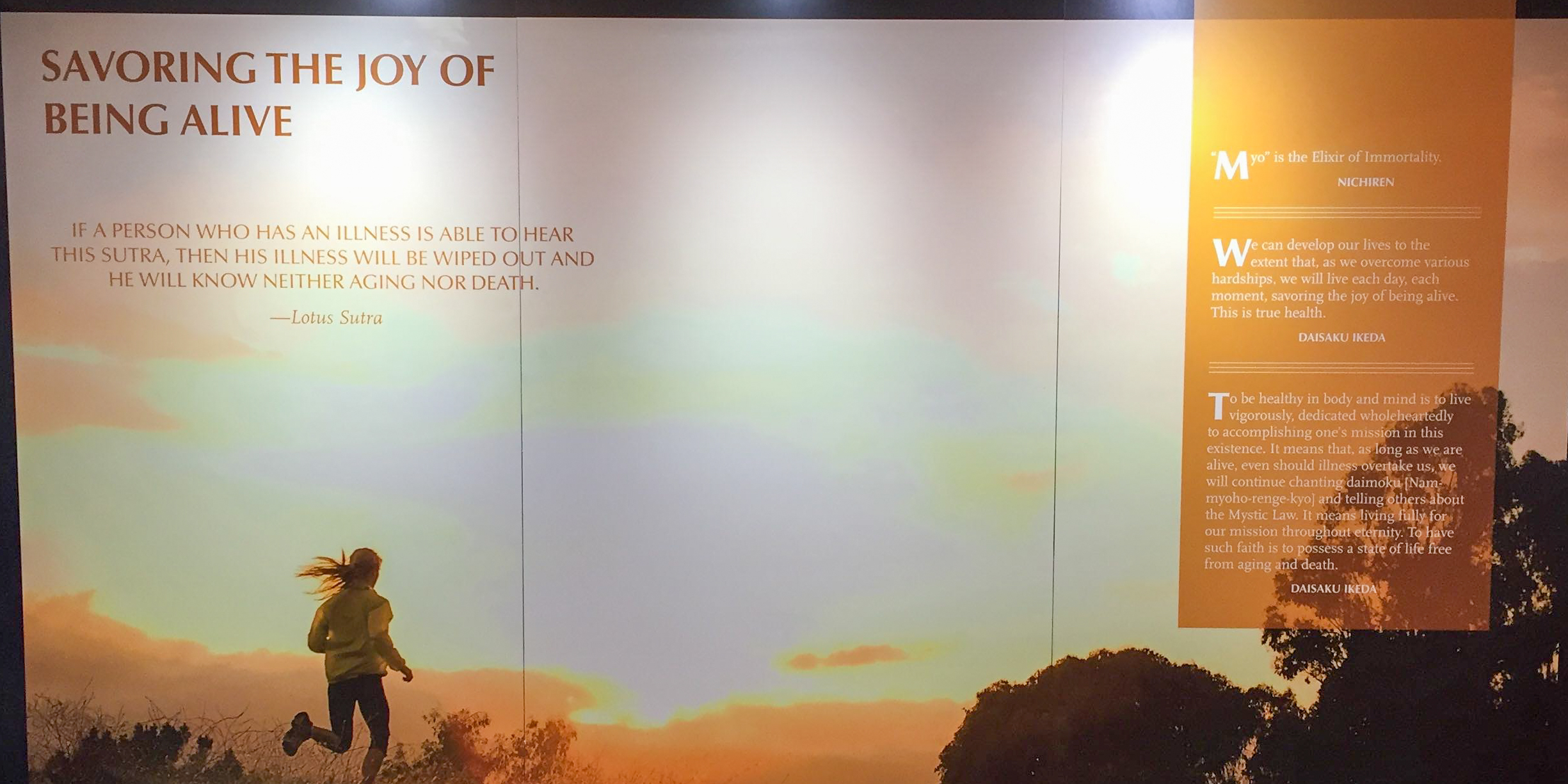
Savoring the Joy of Being Alive
If a person who has an illness is able to hear this sutra, then his illness will be wiped out and he will know neither aging nor death.
The Lotus Sutra and its Opening and Closing Sutras, p. 330
Lotus Sutra, Chapter 23, "Former Affairs of the Bodhisattv Medicine King"
Lotus Sutra, Chapter 23, "Former Affairs of the Bodhisattv Medicine King"
“Myo” is the Elixir of Immortality.
Nichiren Daishonin, Gosho Zenshu, p. 831
We can develop our lives to the extent that, as we overcome various hardships, we will live each day, each moment, savoring the joy of being alive. This is true health.
Daisaku Ikeda, The Wisdom of the Lotus Sutra, vol. 6, p. 6
To be healthy in body and mind is to live vigorously, dedicated wholeheartedly to accomplishing one’s mission in this existence. It means that, as long as we are alive, even should illness overtake us, we will continue chanting daimoku [Nam-myoho-renge-kyo] and telling others about the Mystic Law. It means living fully for our mission throughout eternity. To have such faith is to possess a state of life free from aging and death.
Daisaku Ikeda, The Wisdom of the Lotus Sutra, vol. 6, p. 6

The Heart Is What Matters
Single-mindedly desiring to see the Buddha.
The Lotus Sutra and its Opening and Closing Sutras, p. 271
Lotus Sutra, Chapter 16, “The Life Span of the Thus Come One”
Lotus Sutra, Chapter 16, “The Life Span of the Thus Come One”
Single-mindedly observing the Buddha, concentrating one’s mind on seeing the Buddha, and when looking at one’s own mind, perceiving that it is the Buddha.
Nichiren Daishonin, The Writings of Nichiren Daishonin, vol. 1, p. 390
The mind of an ordinary person who seeks the Buddha becomes the mind of the Buddha itself.
Daisaku Ikeda, The Wisdom of the Lotus Sutra, vol. 4, p. 286
The heart is what really matters. One simply cannot understand Buddhism without a pure seeking spirit stemming from the depths of one’s heart.
Daisaku Ikeda, The Wisdom of the Lotus Sutra, vol. 4, p. 286
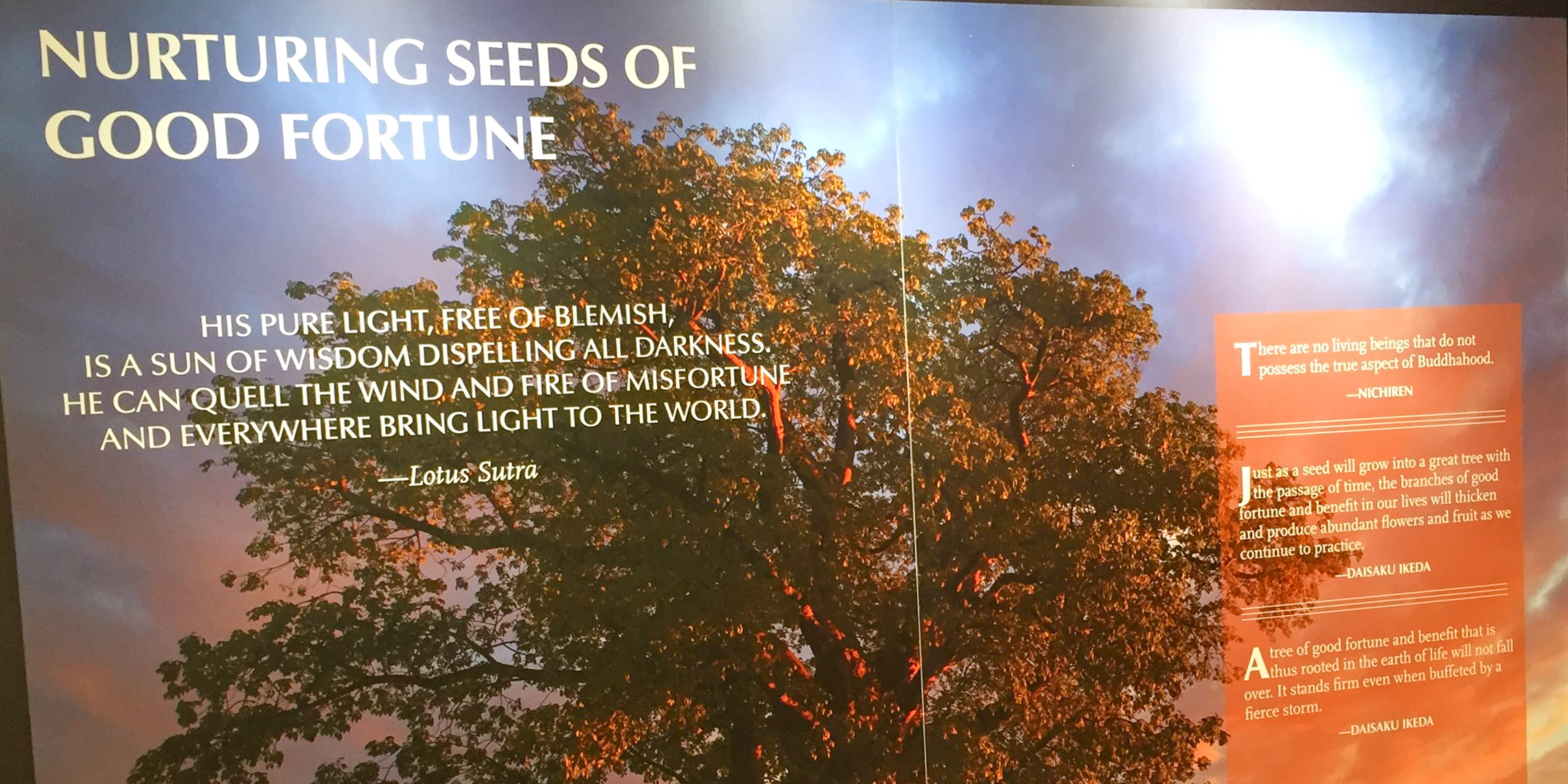
Nurturing Seeds of Good Fortune
His pure light, free of blemish, is a sun of wisdom dispelling all darkness. He can quell the wind and fire of misfortune
and everywhere bring light to the world.
The Lotus Sutra and its Opening and Closing Sutras, p. 346
Lotus Sutra, Chapter 25, “The Universal Gateway of the Bodhisattva Perceiver of the World’s Sounds”
Lotus Sutra, Chapter 25, “The Universal Gateway of the Bodhisattva Perceiver of the World’s Sounds”
There are no living beings that do not possess the true aspect of Buddhahood.
Nichiren Daishonin, The Record of Orally Transmitted Teachings, p. 180
Just as a seed will grow into a great tree with the passage of time, the branches of good fortune and benefit in our lives will thicken and produce abundant flowers and fruit as we continue to practice.
Daisaku Ikeda, The Wisdom of the Lotus Sutra, vol. 6, p. 85
A tree of good fortune and benefit that is thus rooted in the earth of life will not fall over. It stands firm even when buffeted by a fierce storm.
Daisaku Ikeda, The Wisdom of the Lotus Sutra, vol. 6, p. 85
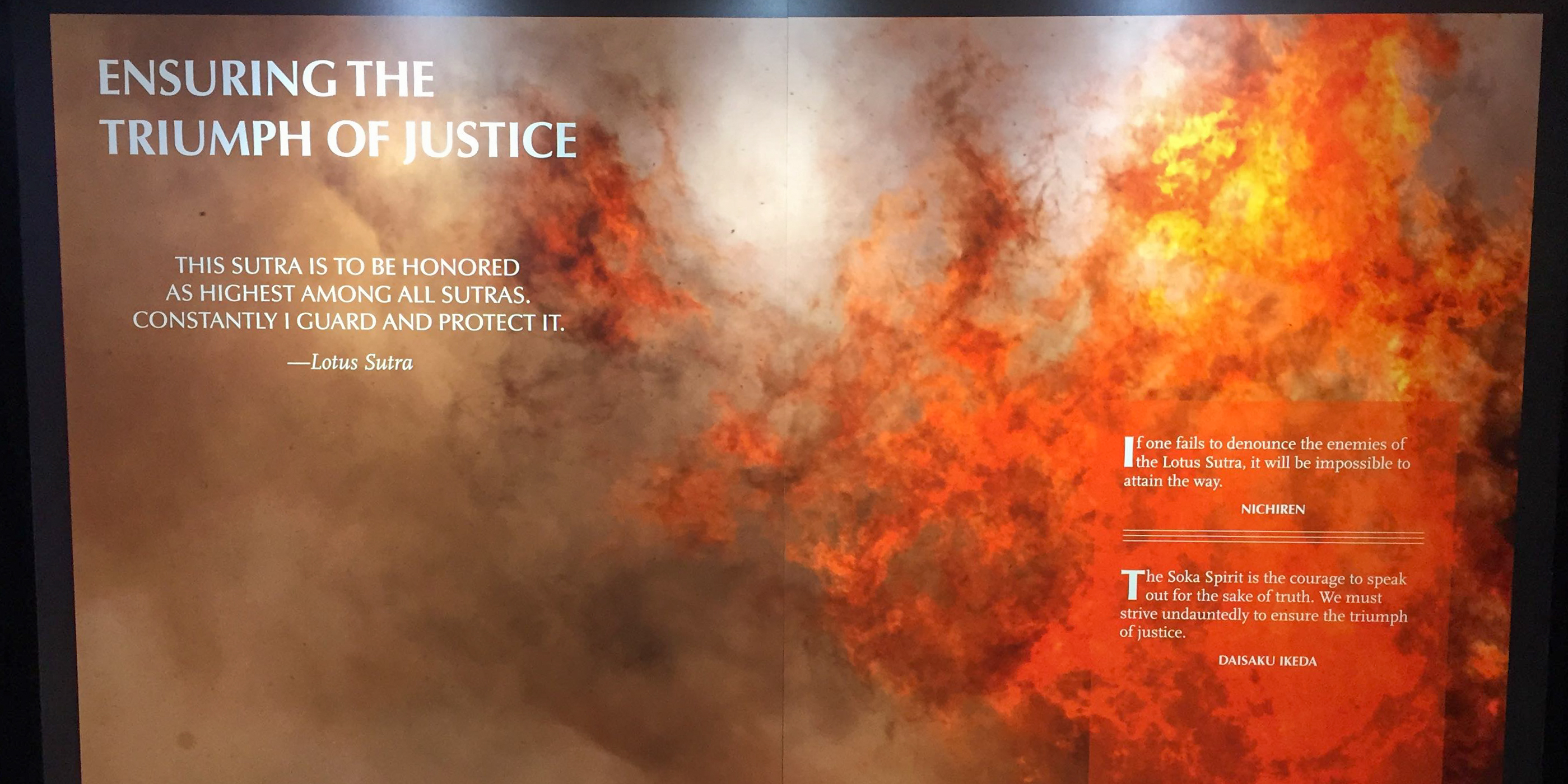
Ensuring the Triumph of Justice
This sutra is to be honored as highest among all sutras. Constantly guard and protect it.
The Lotus Sutra and its Opening and Closing Sutras, p. 248
Lotus Sutra, Chapter 14, “Peaceful Practices”
Lotus Sutra, Chapter 14, “Peaceful Practices”
If one fails to denounce the enemies of the Lotus Sutra, it will be impossible to attain the way.
Nichiren Daishonin, The Writings of Nichiren Daishonin, vol. 1, p. 78
The Soka Spirit is the courage to speak out for the sake of truth. We must strive undauntedly to ensure the triumph of justice.
Daisaku Ikeda, World Tribune, December 13, 2002, p. 2

Bodhisattva Wonderful Sound
This bodhisattva manifests himself in various different bodies and preaches this sutra for the sake of living beings in various different places.
The Lotus Sutra and its Opening and Closing Sutras, p. 336
Lotus Sutra, Chapter 24, “The Bodhisattva Wonderful Sound”
Lotus Sutra, Chapter 24, “The Bodhisattva Wonderful Sound”
“Wonderful sound” refers to the unfathomable and wonderful sound made at the present time, in the Latter Day of the Law, when Nichiren and his followers now chant Nam-myoho-renge-kyo.
Nichiren Daishonin, The Record of Orally Transmitted Teachings, p. 176
When we tune and practice the instrument of the self, we cause the wonderful sound of the universe to pulse in our lives; we cause it to reverberate and ring out.Buddhist practice teaches us how to do this.
Daisaku Ikeda, The Wisdom of the Lotus Sutra, vol. 6, p. 59
While we may exert ourselves in different areas, we are all motivated by compassion and humanity.We should burn with a spirit and determination to become the foremost ally of those who are suffering.
Daisaku Ikeda, The Wisdom of the Lotus Sutra, vol. 6, p. 63

Responding With Joy
The benefits gained by this person will be such that when he is reborn he will be in a place where the Lord Shakra is seated.
The Lotus Sutra and its Opening and Closing Sutras, p. 288
Lotus Sutra, Chapter 18, “The Benefits of Responding with Joy”
Lotus Sutra, Chapter 18, “The Benefits of Responding with Joy”
What a joy it is for us to have been born in the Latter Day of the Law and to have shared in the propagation of the Lotus Sutra!
Nichiren Daishonin, The Writings of Nichiren Daishonin, vol. 1, p. 1026
When we possess the kind of strong faith where we love the Gohonzon, love chanting Nam-myoho-renge-kyo, and love SGI activities, our life overflows with the “benefits of responding with joy.”
Daisaku Ikeda, The Wisdom of the Lotus Sutra, vol. 5, p. 52
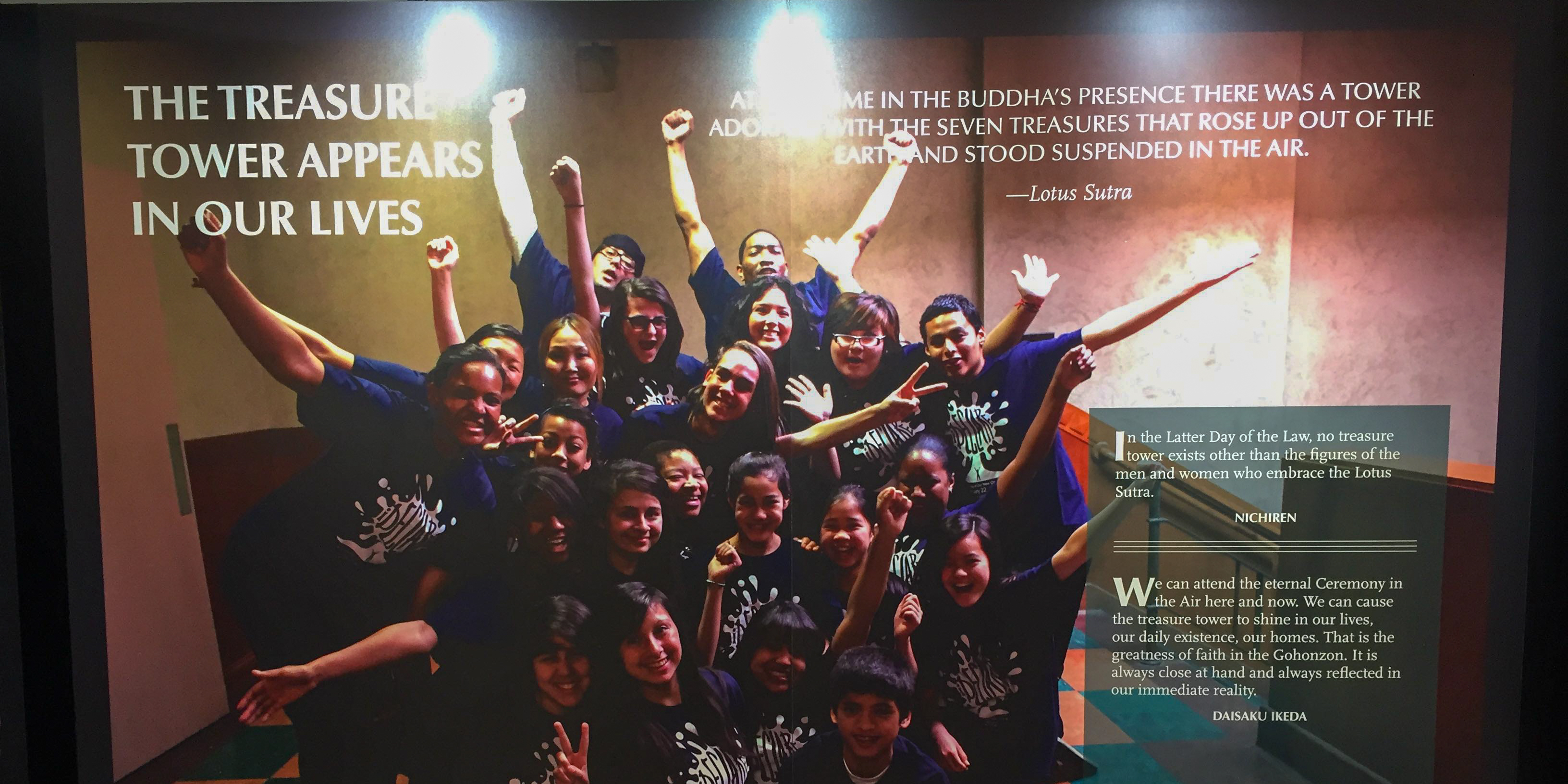
The Treasure Tower Appears In Our Lives
At that time in the Buddha’s presence there was a tower adorned with the seven treasures …that rose up out of the earth and stood suspended in the air.
The Lotus Sutra and its Opening and Closing Sutras, p. 209
Lotus Sutra, Chapter 11, “The Emergence of the Treasure Tower”
Lotus Sutra, Chapter 11, “The Emergence of the Treasure Tower”
In the Latter Day of the Law, no treasure tower exists other than the figures of the men and women who embrace the Lotus Sutra.
Nichiren Daishonin, The Writings of Nichiren Daishonin, vol. 1, p. 299
We can attend the eternal Ceremony in the Air here and now. We can cause the treasure tower to shine in our lives, our daily existence, our homes. That is the greatness of faith in the Gohonzon. It is always close at hand and always reflected in our immediate reality.
Daisaku Ikeda, The Wisdom of the Lotus Sutra, vol. 3, p. 24
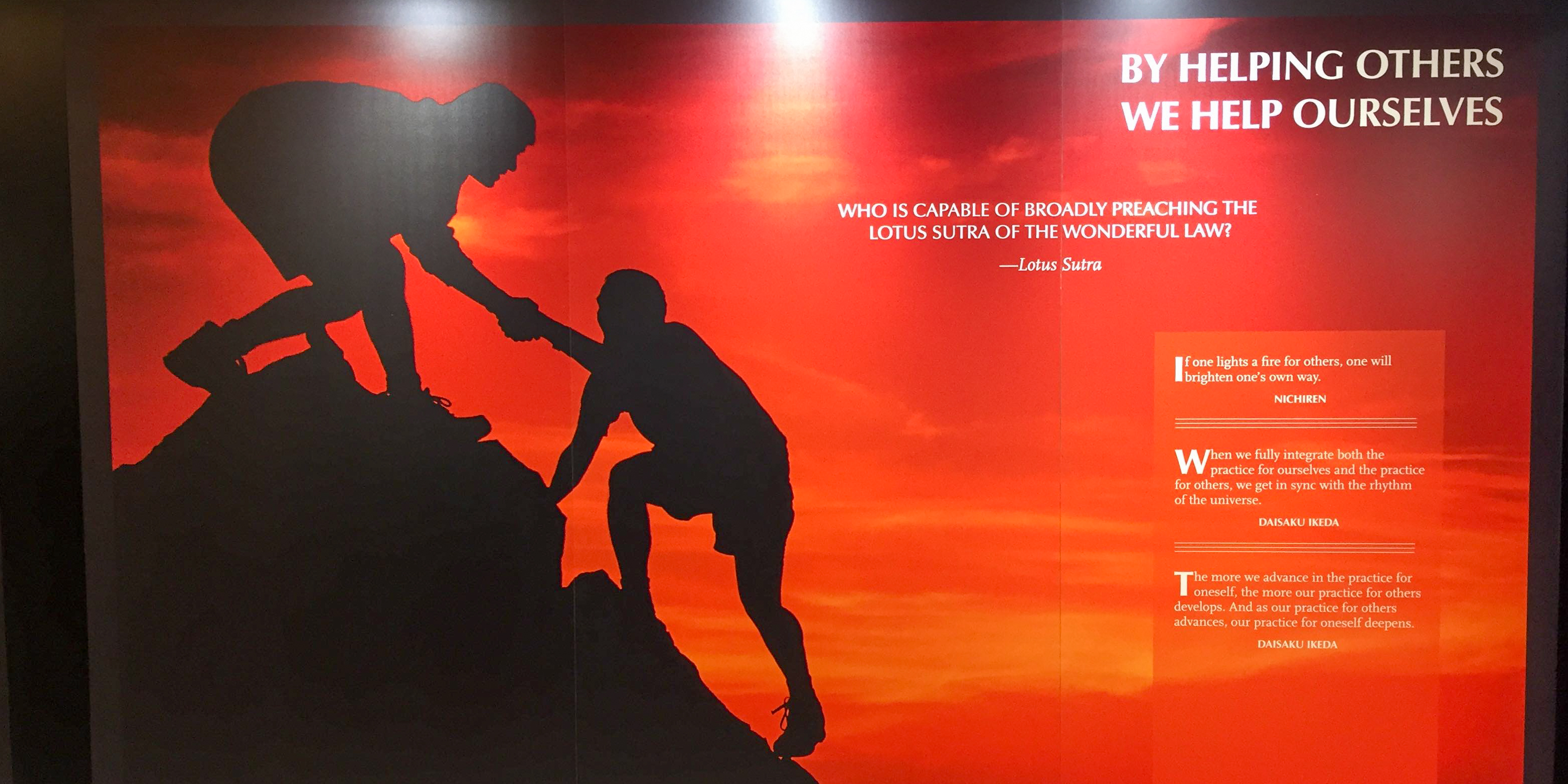
By Helping Others We Help Ourselves
Who is capable of broadly preaching the Lotus Sutra of the Wonderful Law?
The Lotus Sutra and its Opening and Closing Sutras, p. 215
Lotus Sutra, Chapter 11, “The Emergence of the Treasure Tower"
Lotus Sutra, Chapter 11, “The Emergence of the Treasure Tower"
If one lights a fire for others, one will brighten one’s own way.
Nichiren Daishonin, The Writings of Nichiren Daishonin, vol. 2, p. 1060
When we fully integrate both the practice for ourselves and the practice for others, we get in sync with the rhythm of the universe.
Daisaku Ikeda, The Wisdom of the Lotus Sutra, vol. 5, p. 257
The more we advance in the practice for oneself, the more our practice for others develops. And as our practice for others advances, our practice for oneself deepens.
Daisaku Ikeda, The Wisdom of the Lotus Sutra, vol. 5, p. 257
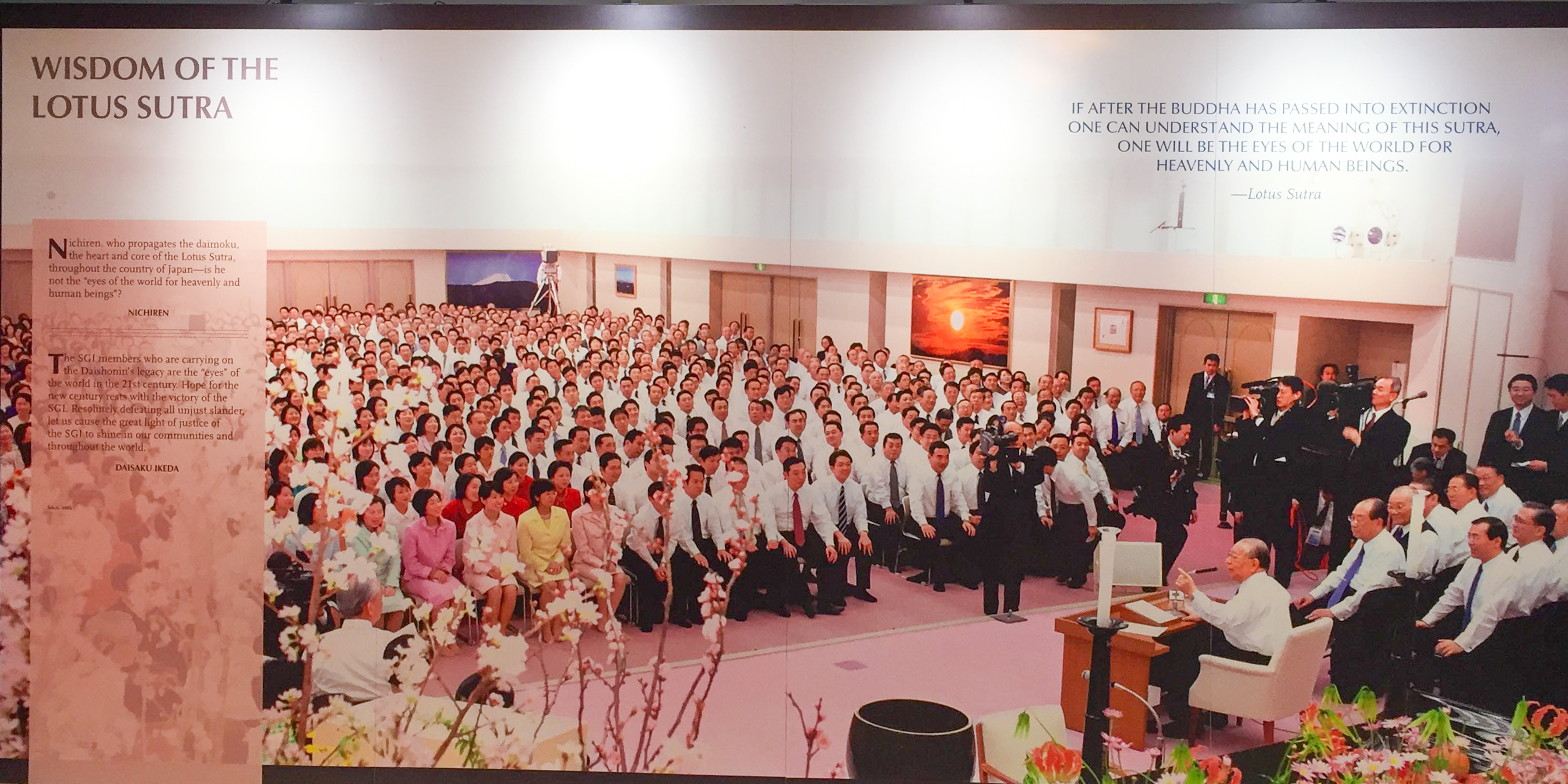
Wisdom of the Lotus Sutra
If after the Buddha has passed into extinction one can understand the meaning of this sutra, one will be the eyes of the world for heavenly and human beings.
The Lotus Sutra and its Opening and Closing Sutras, p. 220
Lotus Sutra,Chapter 11, “The Emergence of the Treasure Tower”
Lotus Sutra,Chapter 11, “The Emergence of the Treasure Tower”
Nichiren, who propagates the daimoku, the heart and core of the Lotus Sutra, throughout the country of Japan—is he not the “eyes of the world for heavenly and human beings”?
Nichiren Daishonin, The Writings of Nichiren Daishonin, vol. 2, p. 927
The SGI members who are carrying on the Daishonin’s legacy are the “eyes” of … the world in the 21st century. Hope for the new century rests with the victory of the SGI. Resolutely defeating all unjust slander, let us cause the great light of justice of the SGI to shine in our communities and throughout the world.
Daisaku Ikeda, World Tribune, June 8, 2001, p. 4
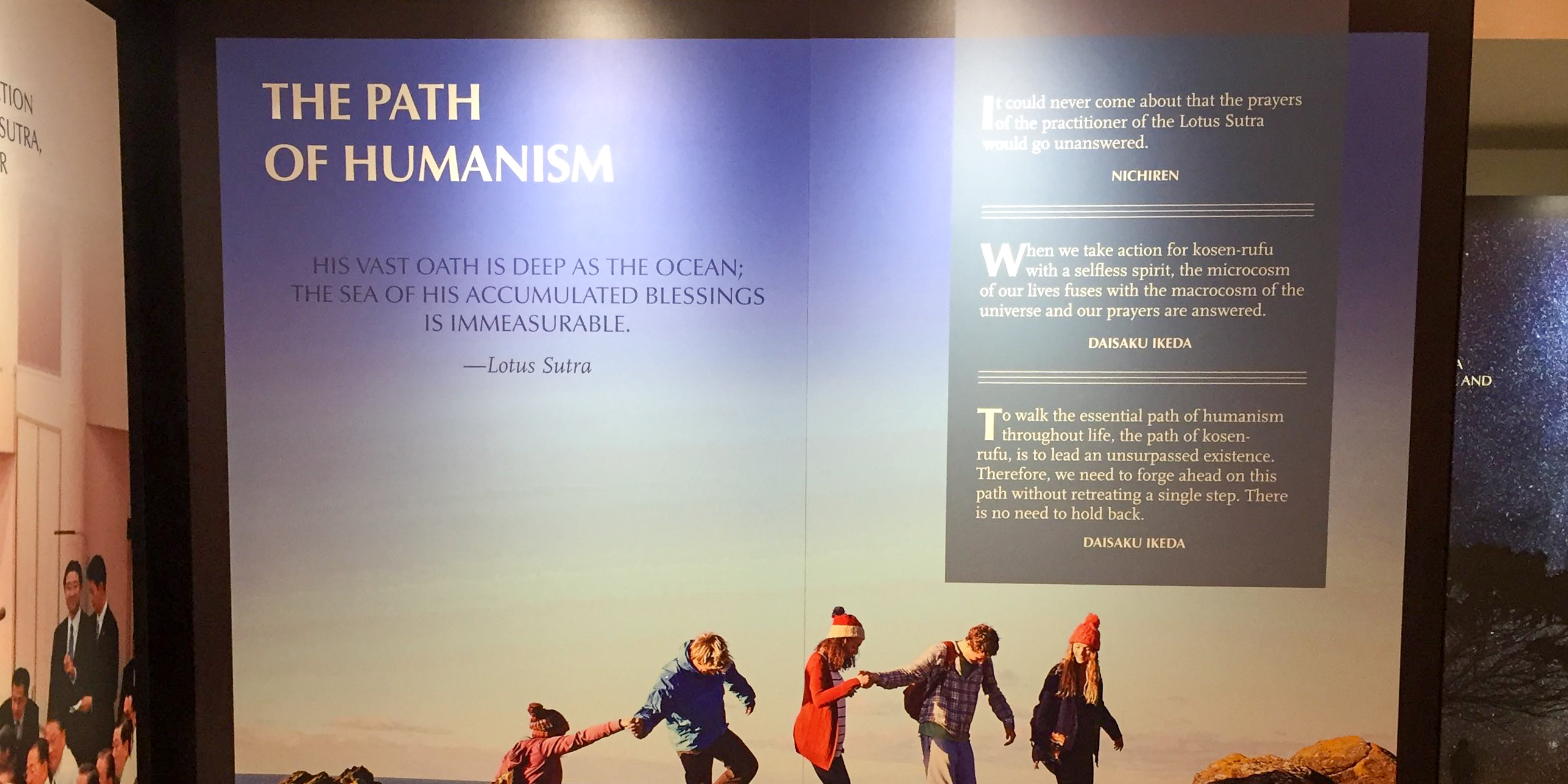
The Path of Humanism
His vast oath is deep as the ocean; …
The sea of his accumulated blessings is immeasurable.
The Lotus Sutra and its Opening and Closing Sutras, pp. 344, 347
Lotus Sutra, Chapter 25, “The Universal Gateway of the Bodhisattva Perceiver of the World’s Sounds”
Lotus Sutra, Chapter 25, “The Universal Gateway of the Bodhisattva Perceiver of the World’s Sounds”
It could never come about that the prayers of the practitioner of the Lotus Sutra would go unanswered.
Nichiren Daishonin, The Writings of Nichiren Daishonin, vol. 1, p. 345
When we take action for kosen-rufu with a selfless spirit, the microcosm of our lives fuses with the macrocosm of the universe and our prayers are answered.
Daisaku Ikeda, The Wisdom of the Lotus Sutra, vol. 6, p. 128
To walk the essential path of humanism throughout life, the path of kosen-rufu, is to lead an unsurpassed existence. Therefore, we need to forge ahead on this path without retreating a single step. There is no need to hold back.
Daisaku Ikeda, The Wisdom of the Lotus Sutra, vol. 6, p. 129
Above are quotes from the Humanism of the Lotus Sutra exhibit at the Florida Nature and Culture Center (FNCC). Only quotes that can be sourced from material available to SGI-USA members are listed. For World Tribune and Living Buddhism references beyond 2019, please use the e-reader at:https://sgiusapublications.pressreader.com/
